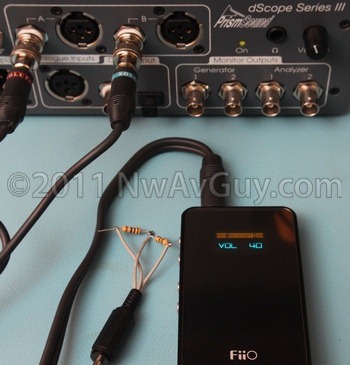 RELATIVE BARGAIN? Since measuring the ill-fated NuForce uDAC-2 many have asked me to recommend a similarly priced DAC with fewer flaws. I suspected the FiiO E7 might be a good choice but a bench test was needed.
RELATIVE BARGAIN? Since measuring the ill-fated NuForce uDAC-2 many have asked me to recommend a similarly priced DAC with fewer flaws. I suspected the FiiO E7 might be a good choice but a bench test was needed.
RAISING THE BAR: This review is the first with several new measurements. I’ve added some tests and improved others to be more consistent with other reviews like John Atkinson’s well respected work for Stereophile. I’ve gone even further beyond the usual difficult to compare RMAA results.
BY ANY OTHER NAME… If a serious headphone-loving audiophile encountered the E7 with no brand name they might easily suspect a stealthy black Apple product. It’s similarly sexy, solid, and hewn largely from black anodized aluminum with impressive tolerances and finishes—much like an iPhone 4. Most wouldn’t blink if you told them it was $300. But, the thing is, its only $99—or even less on eBay. Build quality, however, isn’t everything. The NuForce also made a decent first impression before that train derailed on the test bench.
JUST THE FACTS: The E7 is a 16 bit 48 Khz USB DAC with a line input for analog headphone amp duty. It’s powered either by the USB port or an internal Li-Ion battery. The sundry details have been well hashed in countless other reviews but nearly all omit meaningful measurements. So I’ll just hit the highlights and focus on the measured performance. More info: E7 features and specs.
GETTING PHYSICAL: The footprint is smaller than Apple’s iconic phone but the E7 is more Motorola Droid-like in thickness. The buttons are high quality and the display is easy to read when on and disappears into the stealthy black face when off. It also comes with a nifty silicone protective shell, all the cables, and a soft carrying case—more than you’d expect for $99, or for that matter, than you get with an iPod.
PLUG-AND-PLAY... REALLY: Like the uDAC-2, the FiiO is a Class 1 USB Audio device meaning no drivers for Windows, OS X or (in theory) the right Linux distros are required. And it worked first try with Win 7 and XP.
VOLUME CONTROL: The upper two buttons on the left control the volume in 60 gradual steps with the E7 never leaving you wanting a step in-between. And the balance between the channels remains anchored dead center over the entire range.
Nothing’s ever perfect, however. The first time you press a volume button nothing happens. You have to press it again to change the volume similar to many portable players where the first press “wakes up” the display but doesn’t do anything until you press again. The weird thing is the display is already on. FiiO could easily fix this with a firmware tweak. And, just so you know, the master volume in Windows is forced to maximum when using the E7 as your primary audio device. You can still use the volume control in your player (i.e. Windows Media Player, Foobar, Media Monkey, etc.) but FiiO apparently wants the PC delivering all 16 bits of resolution for maximum audio quality (reducing the volume in windows can also reduce the bit resolution). I didn’t try it on OS X or Linux but I’m sure you can find those details elsewhere.
MENUS: The lower two buttons on the left access the setup menus. You can enable the sleep timer, turn USB battery charging on or off, set a preferred maximum volume setting, enable a button “lock” (which also “sleeps” the display), and enable one of three bass EQ options. It’s all intuitive and the max volume is an especially nice feature if you have really sensitive headphones and/or want to save your hearing.
BATTERY & POWER: I don’t know how accurate the battery meter is, but in all my testing and listening over many hours while running from battery (no USB connected), it only dropped one bar. It’s rated for 80 hours and I can believe it. The battery charges via USB using a computer, inexpensive USB wall charger, or other power source. In fact, using a charger turns the E7 into a desktop amp/DAC you never have to charge or worry about turning off. FiiO gets extra points for using a regular mini-USB connector for both the PC connection and charging. If you lose the supplied cable you probably already have a spare. I didn’t try, but the E7 appears to stay on forever unless you set the sleep timer. If it’s running from battery, it might run itself dead. FiiO could easily fix this in the firmware.
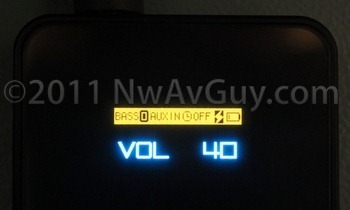 DISPLAY: How many small DAC’s even have a display? Isn’t that more like a $2000 DAC feature? The organic LED (OLED) display looks much like the one in the Sansa Clip right down to the yellow section at the top. Without using the key lock feature, it’s on all the time. As others, like dfkt, have pointed out in their E7 reviews, OLED displays can be prone to eventual “burn in” where the most used pixels lose brightness. This could be a minor problem if you leave the E7 display on for months on end. The key lock option is a somewhat awkward solution if you’re worried about it. This would be a another simple firmware fix if anyone at FiiO is listening?
DISPLAY: How many small DAC’s even have a display? Isn’t that more like a $2000 DAC feature? The organic LED (OLED) display looks much like the one in the Sansa Clip right down to the yellow section at the top. Without using the key lock feature, it’s on all the time. As others, like dfkt, have pointed out in their E7 reviews, OLED displays can be prone to eventual “burn in” where the most used pixels lose brightness. This could be a minor problem if you leave the E7 display on for months on end. The key lock option is a somewhat awkward solution if you’re worried about it. This would be a another simple firmware fix if anyone at FiiO is listening?
SUM OF PARTS = ?: On paper the E7 looks impressive for $99. it sports an audiophile-grade Wolfson DAC, Analog Devices op amp, Li-Ion battery, display, adjustable bass EQ, line input, precision volume adjustment, and Apple-like industrial design. In short, there’s a a lot more hardware here than in the uDAC-2. Yet, somehow, the E7 sells for about 30% less.
FiiO E9 UPGRADE: If you have you have some power hungry high impedance cans, FiiO has an unusual solution: The $129 E9 desktop amp. The E7 cleverly “docks” to the E9 with the E7 handling DAC duties while the E9 has the cojones to drive just about any headphone. It also powers and charges the E7. So you get a portable DAC/Amp, and a high output desktop/home amp/DAC, all for less $$ than many portable amps alone. I haven’t yet tested the E9 but keep reading for the E7’s end of the bargain.
SUBJECTIVE SOUND QUALITY: Before making any measurements I spent some time listening to the E7 as both a headphone amp (driven by my Benchmark DAC1) and as a USB headphone DAC connected to a PC. There were no obvious flaws or red flags like obvious hiss, channel balance problems, rolled off frequency response or obvious distortion.
VOLUME, POWER, & GAIN (updated 5/22): I did max the volume playing some tracks with my Beyerdynamic DT 770 Pro 80’s (which are 80 ohms and fairly inefficient) and 250 ohm Sennheisers. So the E7 does have its limits. The overall maximum gain is well chosen for typical headphones in the USB mode but it’s a unusually low for high impedance phones when using the analog input. This means if your source doesn’t have a lot of output the E7 may not produce full output from the line input. The electronic volume control is quiet when it’s stepping up or down and the step size works well. The maximum output is similar to the NuForce but the max gain in USB mode is lower making more of the volume range usable.
HISS AND NOISE: Even with my uber-sensitive SuperFi 5 Pro headphones the FiiO had only slight audible hiss at any realistic volume setting. It’s notably quieter than the UCA202 and with more normal headphones it’s close to silent at any volume setting.
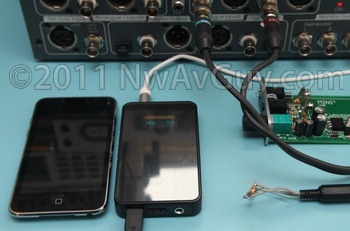 BASS EQ: The Bass EQ was more useful than some might imagine. When using headphones that are bass shy, like my Eymotic IEMs, I found the Bass EQ “1” setting added some useful punch without any real downside—i.e. it didn’t thicken the lower midrange, etc. I wasn’t as crazy about the “2” and “3” settings which are more heavy handed.
BASS EQ: The Bass EQ was more useful than some might imagine. When using headphones that are bass shy, like my Eymotic IEMs, I found the Bass EQ “1” setting added some useful punch without any real downside—i.e. it didn’t thicken the lower midrange, etc. I wasn’t as crazy about the “2” and “3” settings which are more heavy handed.
MEASUREMENT SUMMARY (revised 5/22): Overall the E7 measured well as an under $200 DAC and even better via the line input as a headphone amp. The analog amp was clean with low zero distortion into 150 ohms, very flat extended response, an unusually low output impedance, and enough output for most headphones likely to be used with a portable amp. After hours of torment on the bench, I could elicit only some minor bad behavior: The E7 has limited output into high impedance loads which could be an issue for certain power hungry cans. And this might be made worse as the line input only has 4 dB of gain (USB is fine). There’s a possibility of the line input clipping with some fixed level home sources. And there was some noise well above the audible range that, despite being completely inaudible, some might object to. Here’s a summary (for all the details and graphs, see the Tech Section):
| Measurement | Fiio E7 | Nuforce uDAC-2 |
| Frequency Response 20hz - 20 Khz | +/- 0.1 dB Excellent | +/- 0.1 dB Excellent |
| THD 1 Khz 0 dBFS USB | 0.05% Good | 0.67% Poor |
| THD 1 Khz 150 Ohms 400 mV Line In | 0.003% Excellent | Not Applicable |
| THD 1 Khz 150 Ohms 400 mV USB -3 dBFS | 0.03% Good | Not Measured |
| THD 1 Khz 15 Ohms 400 mV USB -3 dBFS | 0.03% Good | 0.05% Good |
| THD 20 hz 15 Ohms 400 mV | 0.09% Good | 0.06% Good |
| THD 20 Khz 15 Ohms 400 mV | 0.06% Excellent | 1.0% Poor |
| IMD CCIF USB | 0.03% Good | Not Measured |
| IMD SMPTE | 0.008% Excellent | 0.08% Fair |
| Noise (relative to 400 mV A wtd) | -91 dB Good | -94 dB Excellent |
| Max Output 15 Ohms | 113 mW Excellent | 47 mW Very Good |
| Max Output 150 Ohms | 23 mW Fair | 32 mW Good |
| Output Impedance | 0.13 Ohms Excellent | 6.0 Ohms Fair |
| Crosstalk | 63 dB Very Good | 47 dB Fair |
| Channel Balance Error Typical Vol | 0.1 dB Excellent | 1.4 dB Poor |
| Channel Balance Error Low Vol | 0.2 dB Excellent | 10.3 db Poor |
| Jitter USB 16/44 Jtest | < -110 dB Very Good | < -105 dB Fair |
| Square Wave | Very Good | Very Good |
FiiO vs NuFORCE: This really isn’t a fair fight. The E7 has much less distortion and channel balance error along with a much lower output impedance, lower jitter, more output power with typical headphones, optional bass EQ, a line input, portable battery operation, more accessories, and costs less. There are not many well recognized USB headphone DACs under $150. I mention some of the other options in the NuForce review, but so far I’ve only tested these two at the E7 is the clear winner overall.
BOTTOM LINE: The FiiO E7 seems like it should cost more from the moment you lay your eyes and hands on it. And that impression remains when evaluating the performance. The E7 is hard to beat for the price unless you have power hungry full size high impedance cans. It’s also makes a respectable battery powered amp. It’s well worth $99.
FIRST CLASS:
- Improves on the sound of many PCs, laptops and portables with weak headphone outputs
- Respectable measurements and overall performance for the price
- Fine volume steps with excellent channel balance
- Apple-like build quality
- Line input and optional desktop amp/dock (E9) for added flexibility
- Useful accessories included
- Very long battery life
ECONOMY:
- Might not have enough output for some high impedance headphones
- Line input has only 4 dB gain
- Display on all the time
- No auto shut off to save battery
- Disables master volume control in Windows
- Line input can clip with some fixed output home gear
- Headphone amplifier IC is the weak link in an otherwise solid signal path
TECH SECTION:
NEW AND IMPROVED: Because I’ve made a lot of changes, and the E7 is really an amp and a DAC, this Tech Section is longer than usual. I’ve added new measurements, improved a few others, and made the entire blog slightly wider to allow displaying the dScope screen shots in their native resolution—no more click-to-zoom disruptions. While I’ve tried to explain some of the background behind the changes, stay tuned for an upcoming article that discusses all the following measurements in more detail and documents the baseline capabilities of my instruments. I’ve also been making revisions to the article on how I test:
HARDWARE DESIGN: At the heart of the E7 is the well respected Wolfson WM8740 DAC. That’s a relatively high-end part to find in a $99 portable product. The WM8740 lacks USB support so another relatively expensive chip is required for the USB interface—the ubiquitous TI PCM2706 which, in this application, only converts USB to I2S and its analog DAC output is unused. The E7’s analog section is reportedly from another boutique chip company--the low noise 0.0006% THD Analog Devices AD8692. Output duties are handled by the TI TPA6130 which also handles the electronic volume function. When you factor in the expensive Apple-like industrial design, high build quality, graphical display, battery, accessories, etc, it’s hard to imagine selling it for much of a profit at $99.
WINDOWS VOLUME MYSTERY: Does anyone know why the PCM2706 as used here defeats the Windows master volume control but doesn’t when used in other products? I haven’t looked very deep into this but it does seem rather odd. The PCM2706 isn’t exactly a programmable microcontroller. Is the microcontroller in the E7 also talking to the Windows driver? That would require splitting the endpoints between 2 devices which would be a bit odd in this application. Or perhaps the E7 doesn’t really use the PCM2706?
ANALOG FREQUENCY RESPONSE: Via the Line Input the E7 has excellent frequency response and very precise channel balance. It’s within +/- 0.1 dB from 20 hz – 20 Khz. Even at 80 Khz it’s only down 1.5 dB and about 1 dB at 5 hz. The channel balance is also excellent (the lines for each channel, for a given load, are difficult to tell apart) and it changes very little with loading. There’s no meaningful change dropping from 150 ohms (pink/red) to 15 ohms (blue/yellow). The output is obviously direct coupled with solid response down to an ear drum rattling 5 hz:
USB FREQUENCY RESPONSE: Via USB the channel balance error rises from 0.08 dB to 0.22 dB likely due to a slight gain error between the DAC channels. Anything less than 1 dB is generally considered inaudible so this is still very good performance. The graph covers a more narrow frequency range due to the limitations of 44 Khz CD audio. The response has a few more ripples but is still very flat at +/- 0.2 dB from 20 hz to 20 Khz. Unlike many DACs, it doesn’t fall off a cliff as it approaches 20 Khz—showing superior filtering in the Wolfson DAC chip: 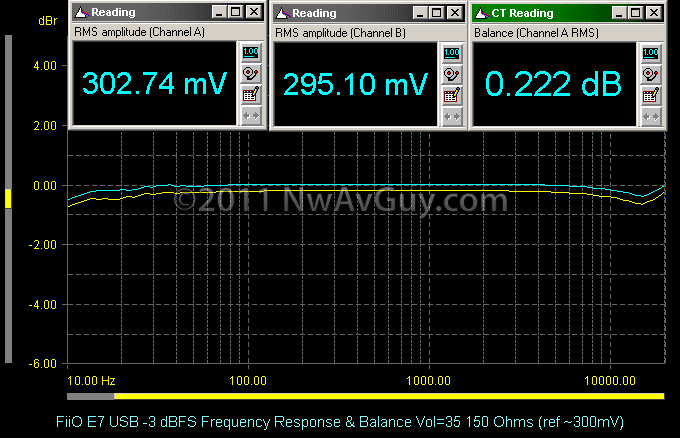
ANALOG THD: The distortion via the line input at 1 Khz with a 150 ohm load and my usual headphone reference level of 400 mV (which is 0 dBr for these tests) was nil. The THD+N is very low around 0.003% These are audiophile-class numbers and, unlike in previous reviews, both channels are shown (in blue and yellow). Note the distortion is mostly 2nd harmonic which is considered the least objectionable sort of distortion but when the numbers are this low, it doesn’t matter:
This is a new measurement showing the residual distortion (in blue) from the spectrum above with the same 150 ohm load in the time domain rather than the frequency domain. The yellow trace is the 1 Khz output scaled in volts: 400 mV RMS is +/- 560 mV peak. The blue trace is the output with the 1 Khz signal removed by the dScope in real time so you’re left with only what the E7 is adding to the signal. Notice the blue scale on the right is in microvolts. The peak distortion is only 0.000004 volts from a 0.4 volt signal and it’s mostly noise with no obvious crossover distortion. This is a test run by Stereophile and yet another example of something you can’t do with RMAA or any soundcard-based test setup I know of:
Here’s the E7 driving a much more challenging 15 ohm load showing a more “closeup” view of the spectrum to only 20 Khz. The distortion rises to a still respectable 0.012% and notice the output level barely drops. But the TPA6130 is having more trouble here than with 150 ohms:
Here’s the residual distortion into 15 ohms which now shows signal related components including some apparent crossover distortion:
USB THD+N: Here’s the same test as above except using a – 3 dBFS digital signal via USB. There’s more 2nd and 3rd harmonic distortion now and you can also see artifacts of the 44 Khz sampling frequency above the audio band. The Wolfson DAC and FiiO low pass filter are doing an impressive job controlling out-of-band noise as it’s mostly below –120 dB. The THD+N, however, increases by about a factor of ten to 0.032%. This is still plenty respectable, and very likely completely inaudible, but the Wolfson DAC is capable of better. The good news is it’s mostly 2nd harmonic which is, by far, the least audible: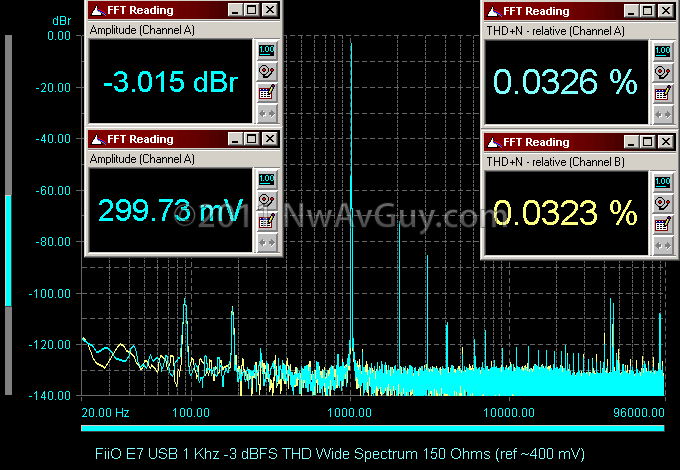
Here’s the residual USB distortion from above in blue. You can see it’s mainly the strong 2nd and 3rd harmonic seen in the spectrum above with no other obvious problems:
FULL SCALE USB THD+N: Some DACs show increased distortion reproducing a full scale 0 dBFS signal. This test indicates how well the DAC can handle clipped signals. A lot of pop recordings are intentionally clipped and frequently hit 0 dBFS (presumably to make them sound “louder”). The NuForce uDAC-2 had dramatically higher distortion on this test as, due to a NuForce design flaw, the DAC itself was driven into analog clipping. With the E7 the distortion rises only slightly from about 0.032% at –3 dBFS (see above) to 0.053% in the worst (blue) channel. The 0.2 dB DAC gain error is likely responsible for the THD difference between the channels. The output level was referenced to approximately the same ~400 mV to keep the analog distortion the same. This is a very good performance:
ANALOG THD 20 Khz 15 OHMS: This is a punishing test (also sometimes called “THD-20”) as the negative feedback in most amplifiers starts dropping well before 20 Khz and 15 ohms is a very challenging load. With less negative feedback available to correct errors, the distortion rises—sometimes dramatically. This test also often reveals poor high frequency stability, feedback loop design errors and PCB layout mistakes creating undesirable parasitic coupling or ground problems. The NuForce uDAC-2 was an epic FAIL on this test with about 1.0% THD+N at 20 Khz. The E7 is twenty times cleaner at only 0.057%. The measurement bandwidth for this test runs out to 80 Khz to include the 2nd and 3rd harmonics of the 20 Khz signal. Also note the frequency response is only down 0.1 dB vs the 1 Khz reference which is also excellent performance:
USB THD 20 Khz 150 OHMS: Same test as above but via the USB digital input. The distortion is lower because it’s into 150 ohms instead of 15 ohms but the idea is to show the DAC itself doesn’t contribute any significant high frequency distortion components with the measurement extending out to 80 Khz:
ANALOG THD 20 hz 15 OHMS: Measuring THD at 20 hz into a difficult load stresses an amplifier in different ways. It requires sustained amounts of current from the power supply and stresses any electrolytic coupling (DC blocking) capacitors in the signal path. It can even reveal thermal distortion in the output devices. The distortion of the E7 rises from 0.012% at 1 khz into 15 ohms to about 0.09% at 20 hz. But the good news is it’s almost all 2nd harmonic which is the least audible. The third harmonic is down over 90 dB. The ear is also less sensitive to low frequency distortion. This is likely related to the negative rail power supply and/or power supply filtering in the E7. The FiiO E5 also suffers from rising low frequency distortion but it’s about ten times higher. Overall this is respectable performance for a battery powered device generating its own power supply and nearly anyone would consider this inaudible:
USB THD 20 hz 150 OHMS: Again, the distortion is much lower into the easier load and the DAC isn’t contributing any unexpected distortion so this is a good result. You can see the 44 Khz sampling artifacts:
ANALOG THD+N vs FREQUENCY: Here’s the THD vs frequency for both channels into both loads. The lower set of traces are the left and right channels into 150 ohms and the upper set into 15 ohms (the caption has them backwards). You can see the rising low frequency distortion mentioned above. The measurement bandwidth here is out to 22 Khz which explains why the 15 ohm distortion falls above 10 Khz. But it’s still extremely impressive the distortion stays so low at high frequencies (see THD 20 Khz above):
USB THD+N vs FREQUENCY: This is the same as above but feeding a digital signal from the dScope to the DAC and only at 150 ohms. Again the result is impressively flat with frequency and the low frequency rise above up to 0.02% at 20 hz is masked by the 0.03% THD of the DAC. The dip before the rise is due to the analyzer cutting off harmonics that are above the audible range. This is very good performance all the way around: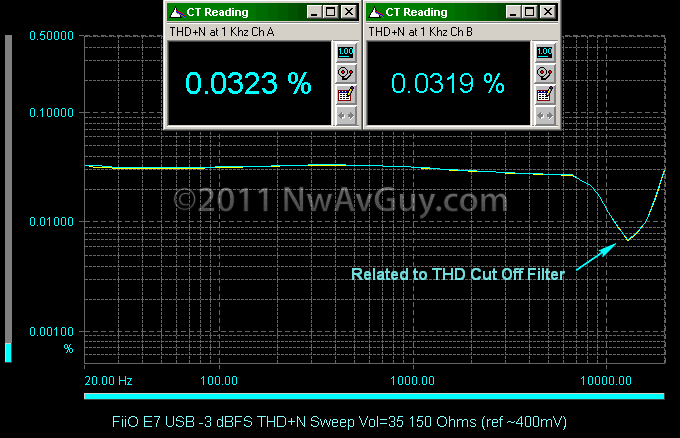
ANALOG IMD CCIF: This is another new test that’s both challenging and revealing of particularly audible kinds of distortion. Stereophile performs this measurement with an Audio Precision analyzer and it cannot be done with RMAA. Two high level high frequency tones at 19 Khz and 20 Khz interact with any non-linearities creating distortion products at multiples of the difference between the two frequencies. Interestingly, the more friendly even-order distortion products show up at 1 Khz, 2 Khz, etc, while the generally more objectionable odd-order distortion products show up as “side bands” to the high frequency signals (i.e. at 18 Khz, 21 Khz, etc.). Here the E7 does well at 0.003% overall but it’s worth noting the two sidebands at about –74 dB which are some slight cause for concern and it turns out they’re related to the punishing 15 ohm load. Again the TPA6130 is showing its limitations:
USB IMD CCIF: This is a repeat of above except into 150 ohms via the digital USB input. Note the distortion product at 1000 hz is 20 dB higher than above. This is from the higher 2nd harmonic distortion of the DAC (and the main reason for the increase from 0.003% to almost 0.03%). But also note the sidebands marked above have dropped from –74 dB to around –85 dB. This demonstrates these are caused by the more punishing 15 ohm load used above. The DAC itself is mostly free of problems here besides the relatively benign 2nd order spike at 1 Khz:
SMPTE IMD: This is the SMTPE version of IMD using 60 hz and 7 Khz tones at different levels. Here the analog and USB performance were very similar so I’m only showing the analog result. The only area of note is the 2nd harmonic of the 60 hz signal at –72 dB. This is a THD component, not an IMD distortion product and is due to the rising low frequency distortion into 15 ohms noted earlier. This is not included in the 0.0076% number because it’s not at a frequency related to the interaction of the 60 hz and 7 Khz tones. The calculation of true SMPTE-DIN IMD is relatively complex and something RMAA appears to get consistently wrong. The IMD products of interest are all clustered around the 7 Khz signal and impressively below 90 dB. This is very good performance:
OUTPUT IMPEDANCE: This is a critical measurement for anything designed to drive headphones. As discussed in my article on impedance the lower the better for most applications. As show below, the E7 produced 402.0 mV into essentially no load (100,000 ohms). Into 15 ohms (see above) it managed 398.6 mV which calculates out to a very impressive 0.13 ohms:
MAXIMUM LINE INPUT LEVEL: The E7’s input clips around 1.25 volts RMS. That should work fine with the line output on an iPod, PC, or anything with an adjustable output. But some home audio equipment, like home CD players, can have fixed outputs producing around 2 volts RMS at 0 dBFS. Such gear, if you can’t lower the output, would cause some peaks to be clipped by the E7. 1.25 volts is 3.5 v p-p. With the E7 running on a 3.7 volt battery it’s easy to see why it clips at 3.5 volts. Fixing this correctly would require a true split rail supply for all the analog circuitry—not just the headphone power amp in the TPA6130.
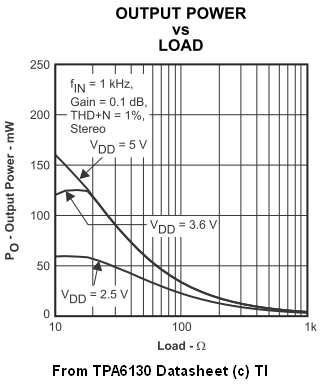 MAXIMUM OUTPUT & THD vs OUTPUT: I’ve improved this test to provide much more information. And, again, this is something you just can’t do with RMAA or any soundcard-based measurement system I know of. The dScope plots the THD+N along the left over the entire range of output power along the “X” axis. Because it’s a THD+Noise measurement, noise will dominate at very low levels on the left and clipping distortion dominants on the right hand side. This is directly comparable to the Audio Precision THD+N sweep Stereophile uses.
MAXIMUM OUTPUT & THD vs OUTPUT: I’ve improved this test to provide much more information. And, again, this is something you just can’t do with RMAA or any soundcard-based measurement system I know of. The dScope plots the THD+N along the left over the entire range of output power along the “X” axis. Because it’s a THD+Noise measurement, noise will dominate at very low levels on the left and clipping distortion dominants on the right hand side. This is directly comparable to the Audio Precision THD+N sweep Stereophile uses.
When I first wrote this review I didn’t realize the E7 is using the TI TPA6130 as the output amplifier but someone was kind enough to point it out in the comments below. I ran this test running from the internal 3.7 volt battery using the line input and the TI datasheet shows the TPA6130 produces about the same output from 3.7 or 5 volts with a 20 ohm or higher impedance load (see graph to right). The graph allows estimating the power into various load impedances. The TPA6130 uses a charge pump to generate a negative power supply that “mirrors” the positive supply. This doubles the total power supply voltage and eliminates the need for distortion-inducing output capacitors or the added complications of a rail splitter.
Even on battery power, the E7 manages about 113 mW into 15 ohms which handily beats the uDAC-2 even on USB power. Connected to USB, according to the graph, 140 mW could be expected. And into 150 ohms it still manages a respectable 23 mW. The 15 ohm performance is due to the TPA6130’s limited output current capability . In summary, the E7 should do fine with all but power hungry high impedance headphones:
GAIN (added 5/22): With a full scale USB digital source the E7 has about 12 dB of added gain beyond 400 mV. It has no problem reaching clipping via USB. With an analog input, however, it only has about 4 dB of gain at the maximum volume setting (Volume 50 is 0 dB or unity gain and Volume 60 is the maximum). 4 dB is about 1.6 times. So to reach 1.3 volts out it needs about 0.8 volt input and that’s more than a lot of portable players can manage. With a more typical 0.45 volts maximum input, you’ll get 0.72 volts out. That’s 32 mW into 16 ohms but only 6 mW into 80 ohms and a downright weak 2 mW into 250 ohms. I suspect at least part of the problem here is the volume control is in the headphone chip amp, and any extra gain before the chip amp would just make the input clipping problem mentioned above worse. So perhaps this is the best compromise FiiO could come up with? Still, just to be clear, it’s not a problem if you intend to use the E7 as a USB DAC.
ANALOG INPUT NOISE: I deviate a bit from traditional noise measurements. Signal to noise ratio is often measured against maximum output (sometimes shown as “dBc”) to obtain a more impressive number. It also often changes with the volume control setting. Sometimes the only way to reproduce a manufacture’s lofty spec is to crank the volume up and push the device into clipping to obtain the reference level, then they turn the volume all the way down with no input and take the noise measurement. That yields a completely unrealistic number. Even leaving the volume alone and using clipping as the reference makes it hard to compare between different devices. Instead I use a typical fixed volume control setting and a more typical reference level. For headphone outputs I use 400 mV RMS. The result is usually at least a few dB less favorable than if I measured the unrealistic way. The benefit is you can compare my noise measurements across products and have a much better idea of how much noise there will be in typical real-world use.
The E7’s noise measurements require some explanation. The unweighted measurement is oddly marred by noise at 90 hz and 180 hz. I’m guessing these are created by the TPA6130’s charge pump (generating the negative supply rail). The good news is the ear isn’t very sensitive at low frequencies and, try as I might, I couldn’t hear the 90/180 hz noise components even with my most sensitive headphones. This is reflected in the respectable A-Weighted number of nearly –91 dB. The weighting is an industry standard adjusting the measurement to the ear’s sensitivity at various frequencies. It’s typically what you see in manufacture’s S/N specs (even if they don’t disclose the weighting). By comparison the FiiO E5, which is also respectably quiet, measured 3 db worse at –88 dB A-Weighted. It’s worth noting the actual “hiss” portion of the noise spectrum is relatively low. With the volume set to 80% the spectrum above 600 hz is at about –125 dB which is slightly better than the NuForce uDAC-2 and much better than the E5 or UCA202. And, as shown in red, it gets even lower if you turn down the volume to a more typical setting. This is a long way of saying the subjective noise performance of the E7 is better than the following might lead you to believe:
USB NOISE: Here’s the digital version of the above referenced to the same 400 mV using a digital 1 Khz signal at –115 dBFS to keep the DAC from going into mute—that’s the spike you see at 1 Khz. Here, with the analog input disabled (which may remove some gain and hence noise) and the volume set to 35 (determined by 0 dBFS level), the E7 does significantly better than above but the weird components at 90 & 180 hz are still there, just lower in level:
STEREO CROSSTALK: This shows the channel separation with a worst case 15 ohm load. Crosstalk tends to be worse into low impedance loads due to greater power supply interaction, higher modulation effects, and increased crosstalk between PC traces due to higher currents and electromagnetic coupling. The E7 does very well here with > 60 dB across the entire spectrum even up to 80 Khz:
VOLUME TRACKING: The graph below shows both the fine steps of the volume control (about 0.5 dB each) and the tight tracking between the channels (something the uDAC-2 did very poorly with):
Even at the lowest volume settings the E7 tracks very well (slightly better even!). This is where the NuForce went from bad to horrible. Here are the 5 quietest settings and you can see the pairs of traces for each are still very closely matched between the channels:
BASS EQ MEASUREMENTS: Here’s the effect of the three bass EQ settings (four if you include “off” shown in green). The “1” setting, shown in red, is probably the most useful unless you like more boom than thump in your bass:
JITTER: The E7 uses the TI (formerly Burr Brown) PCM2706 to convert USB to I2S. The PCM2706 does a reasonable job on its own with jitter. To quote the spin-meisters at TI: “analog PLL’s with SpAct enable playback with low clock jitter.” The E7 adds the Wolfson DAC’s jitter rejection but it’s all very implementation dependent. Anything that skews, distorts, or adds noise to the internal digital signals and clocks can easily degrade jitter performance. The devil is very much in the details. Please see my jitter article for more.
Periodic jitter is revealed as symmetrical pairs of “sidebands” around the main signal. While “spread” at the base of the main 11,205 hz signal indicates random low frequency jitter. With the E7 the side bands are about 1000 hz apart and impressively below –110 dB. The spread is also relatively minimal and stays below –110 dB. This is significantly better than the NuForce and UCA202. The absolute frequency (clock) accuracy is right on (the dScope adds approximately 0.2 hz to the frequency reading):
DAC LINEARITY: The E7 had virtually perfect linearity at –90 dB as can be seen by the center number below. The THD figure is real and is a good indication of how much distortion is present when the DAC is reconstructing a signal from very few bits and the dither noise. 1% is relatively respectable:
PHASE: Here’s another new measurement. The phase response of the E7 via the line input is within +/- 10 degrees over the audio range and off by only 6 degrees at 10 Khz. This is acceptable if not stellar performance:
USB SQUARE WAVE PERFORMANCE: Here’s the 1 Khz square wave performance with a USB digital input. The yellow trace is the dScope’s conversion of the digital signal, and the blue trace is the E7’s output into Sennheiser CX300 16 ohm headphones. A realistic load, like the CX300’s can reveal instability, ringing, and other problems. There are no surprises here although the “ripple” is somewhat different than I’m used to seeing: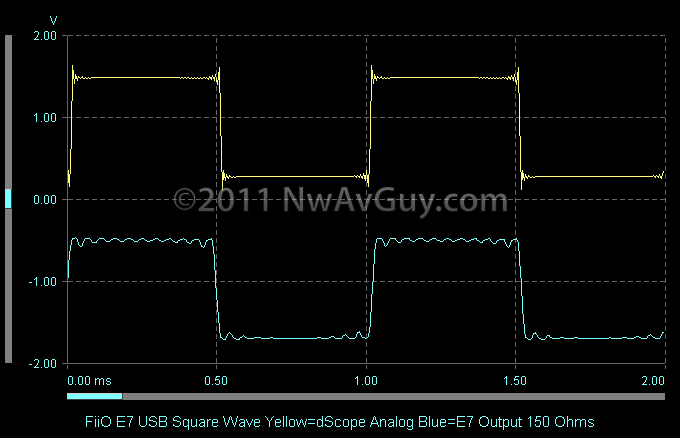
ANALOG SQUARE WAVE PERFORMANCE: The analog square wave response requires some explanation for the noise and rise time—see the RF Noise and Slew Rate sections below. The red trace is the lab-grade 10 Khz square wave input and the upper blue trace is the roughly 1 volt p-p output of the E7 driving Sennheiser CX300 16 ohm headphones as viewed on a 100 Mhz wideband oscilloscope:
RF NOISE EXPLAINED: If I was making the usual soundcard-based, or even dScope/Audio Precision analyzer measurements, you would never even see the noise shown on the square wave above. It’s not something you’ll find in say a Stereophile review but I’m all for telling it like it is. The RF noise has an average value of only about 35 mV and it decreases with lower signal levels and easier loads. The spectral energy is entirely above 400 Khz and hence well above the audio spectrum.
E7 FORENSICS: Because the noise is worse on the negative half of the square wave it’s clearly from the 400 Khz charge pump power supply built into the TPA6130 output amplifier. If it’s any consolation this sort of noise is very common with Class-D and similar amplifiers including some that cost many thousands of dollars and receive very favorable audiophile reviews. The FiiO E5 has a similar noise RF noise signature and likely uses the same TI output amp.
DESIGN CHOICES: I didn’t run this test on the NuForce uDAC-2 but it likely has similar noise as well. There are only four choices open to a designer for a USB (or single cell battery) powered DAC:
- Single 5 Volt Supply – Using only the 5 volt USB supply saves money but limits performance. It limits the output voltage swing to about 1.3 volts RMS, or even worse into more difficult loads. This makes it a poor choice higher impedance headphones. It also requires the headphone output be capacitor coupled with a large and relatively expensive output capacitor to avoid low frequency roll off and increased distortion into low impedance headphones. So you end up with more low frequency roll off and potentially audible distortion. The Behringer UCA202 headphone output suffers these problems but it also sells for only $29.
- Rail Splitter – This is employed in some “Cmoy” style op-amp designs. It uses an internal reference at half the power supply voltage that becomes a sort of “fake ground” for the headphones and allows the amplifier to be direct coupled. The benefit is you get rid of the output capacitor. But in its place, you have any flaws in the rail splitter compromising the performance and the better rail splitters tend to be power hungry making them a poor choice for battery powered devices. And, even worse in this case, the total voltage swing is still just as limited as with the single 5 volt supply. I don’t like fake milkshakes and I don’t usually like fake grounds either.
- Fully Isolated DC-DC Bipolar Converter – This is the most expensive solution. It also takes up more space and uses more power. The 5 volt USB source (and/or battery) powers a DC-DC power supply that generates two isolated +/- power supply “rails”. The DC-DC converter will generate some amount of noise above the audible range much as you see above from the E7. How well it’s kept out of the audio depends on the circuit design, type of converter, how much physical isolation can be obtained (difficult in a pocket device like the E7) and other factors. The benefits are wider voltage swing, true +/- supply rails with no “fake ground” compromises, true isolation, and no output caps required. The HRT DACs use this solution.
- Inverting Charge Pump – This method also yields a true bipolar power supply but costs less, takes up less space, and increases efficiency (important for battery operation). Filtered USB/battery power is used for the positive rail and only the negative rail is generated. A charge pump cleverly charges a capacitor, disconnects it from the positive supply, flips it over, and connects it to the load creating a mirrored negative supply. And while that cap is powering the load, a 2nd cap is charged. It switches back and forth between the 2 caps always charging one while the load runs from the other. It does this very rapidly—400,000 times per second in the E7. As you might imagine this switching creates some electrical noise in the negative supply from all the switching and positive side from the spikes of current drawn to charge the capacitors.
DESIGN ERROR? Did FiiO make the best choice? If I were designing a pocket portable DAC to sell for $99 I’d probably also use an inverting charge pump to generate the negative rail. It’s the best compromise in this application. The TPA6130 offers a cost effective, battery-friendly solution that performs relatively well as the measurements have shown. But it is one of the weaker links in the E7’s entire signal chain. Running the entire design on a split supply using a dedicated charge pump and using a better headphone amp would offer some improvements in several areas. But it also would have added cost, decreased battery life, and possibly even made the E7 larger, with little audible benefit to most users.
SLEW RATE: Despite what you may have heard or read you only need 0.2 V/uS slew rate per volt of RMS output to perfectly reproduce any signal you’ll ever find on a CD. That number has been verified by several well respected audio engineers like Douglas Self. And it’s conservative--It assumes a worst case full output at 20 Khz which pretty much never happens anywhere but on a test bench. The E7 has about 1.8 volts maximum output, so it needs 0.36 V/uS for the absolute worst case.
The measurement table at the top of the graph below shows a dV (delta or change in voltage) between points 1 and 2 on the graph of 0.48 volts and a dt (delta time) of 1.3 uS. This works out to a measured slew rate of 0.37 volts/uS which is coincidentally so close to the theoretical value one might suspect FiiO and/or TI (with the TPA6130) designed it that way—and they probably did. Designing an amplifier to be faster than needed often involves other design compromises (faster op amps are typically more noisy and power hungry than slower ones for example). I verified the E7 can produce a 20 Khz sine wave at 1.8 volts without a significant rise in distortion so I’m entirely satisfied it’s as fast as it needs to be for any real world signal it will encounter. A faster design would certainly perform no better reproducing 44 Khz sampled audio and may well perform worse in other ways.
In this case, TI apparently worked hard to keep the power consumption of the TPA6130 down. Lower bias levels, and low power amplifiers, tend to be slower. But, in this case, some would consider this careful engineering. They made the TPA6130 (and FiiO made the entire E7) fast enough so the slew rate cannot limit its performance:
DAC IMPULSE RESPONSE: This is another new test showing an 8 sample digital pulse. The response shows the E7 has accurate polarity (it doesn’t invert via USB or the line input) and exhibits nearly symmetrical pre and post ringing indicating the Wolfson DAC is using a classical steep slope output filter. There’s nothing to worry about here unless you were hoping for the much less common linear phase or other more esoteric filtering:
THE FINE PRINT:
- FiiO E7 Firmware: FW01JLY31JA
- Audio Analyzer: Prism dScope Series III with Version 1.4 software
- Operating System: Windows 7 Ultimate 64 bit & XP SP3
- Volume Settings: Unless otherwise noted, line input analog tests utilized unity gain (Volume set to 50) and USB tests set for a 400 mV RMS output with 0 dBFS input (Volume set to 35).
- Line Input measurements made while running from battery. USB tests conducted with USB Charging disabled. This may have reduced maximum output possible with a power source connected.
GEEK’s VERDICT: The biggest compliment I can pay the E7 is I can’t find much I would change for a portable product in this price category. But, in a perfect world, I’d add probably consider:
- A better headphone output amp with lower noise and more output swing for high impedance headphones.
- A true split rail supply (versus the one built into the TPA6130).
- Use the split rail supply to raise the line input clipping point above 2 volts RMS.
- Reduce the Wolfson DAC distortion to be closer to the analog performance.
- Tweak the firmware to improve usability as I suggested in the first part of the review
The biggest real-world issues are the maximum output into high impedance loads and the input clipping level. If you have relatively inefficient cans and like to listen loud, or to wide dynamic range content, the E7 might clip the peaks. And if you plan to use a home CD player, or similar, that only has a fixed output level make sure it’s under 1.25 volts RMS max output.
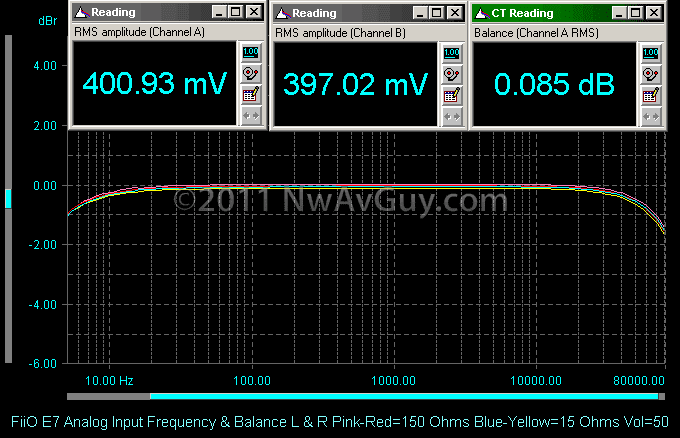
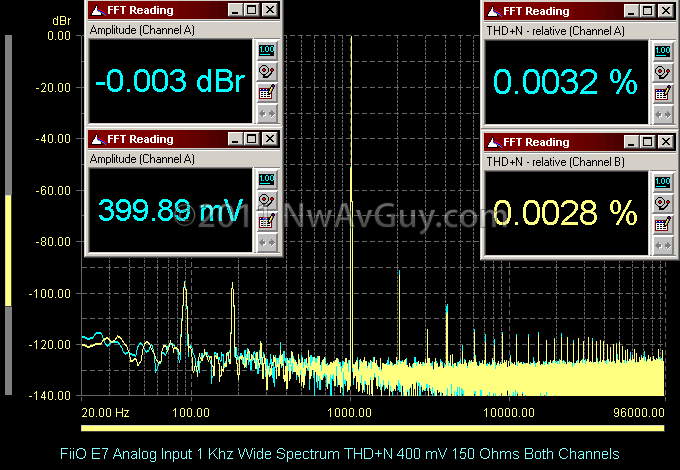

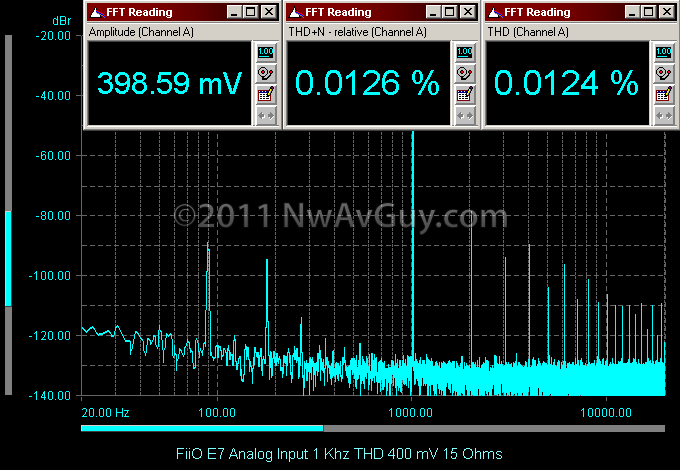
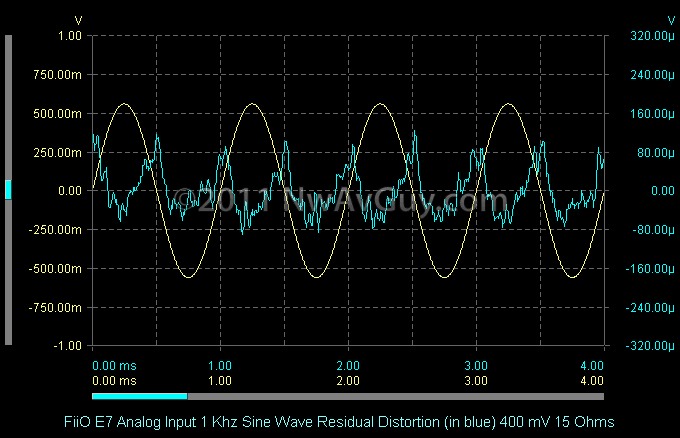
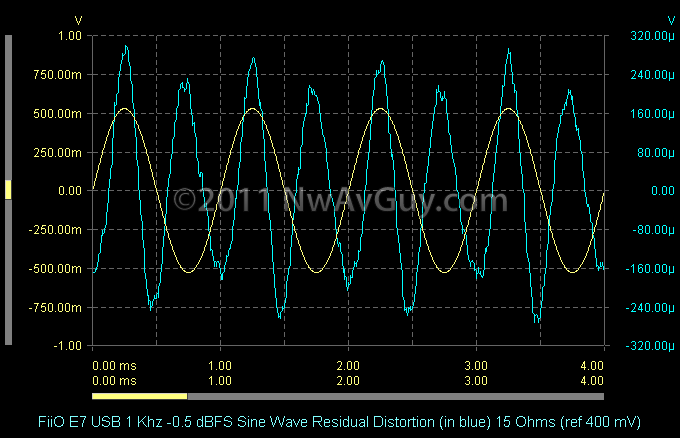
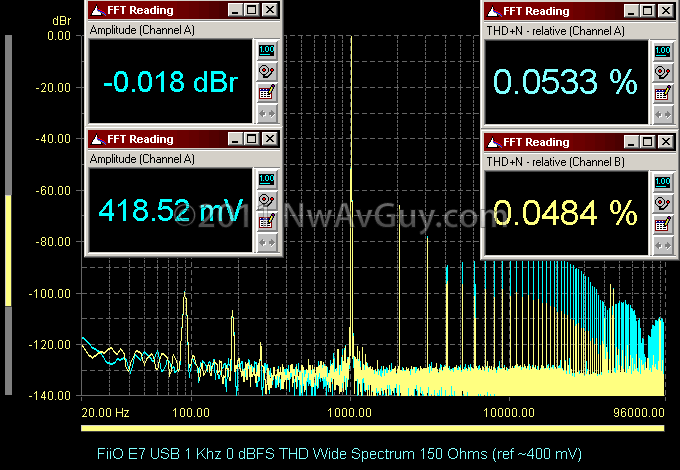

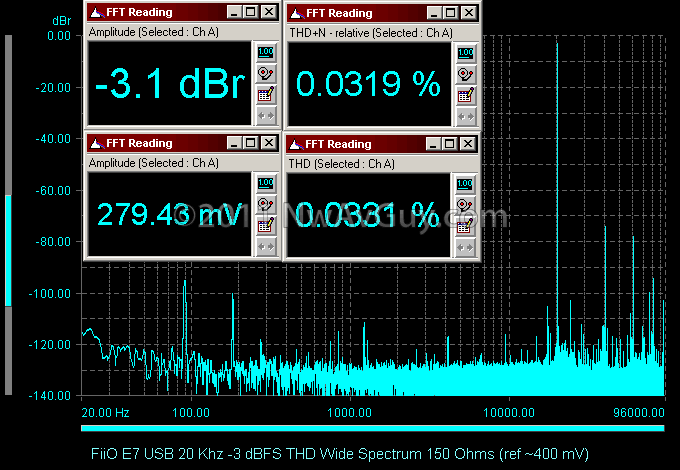
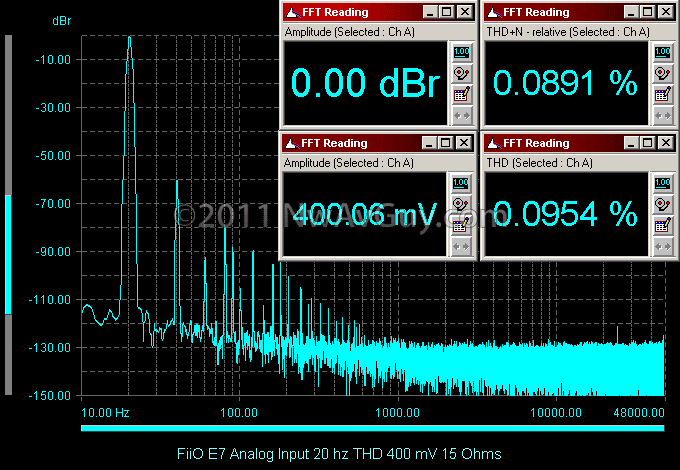


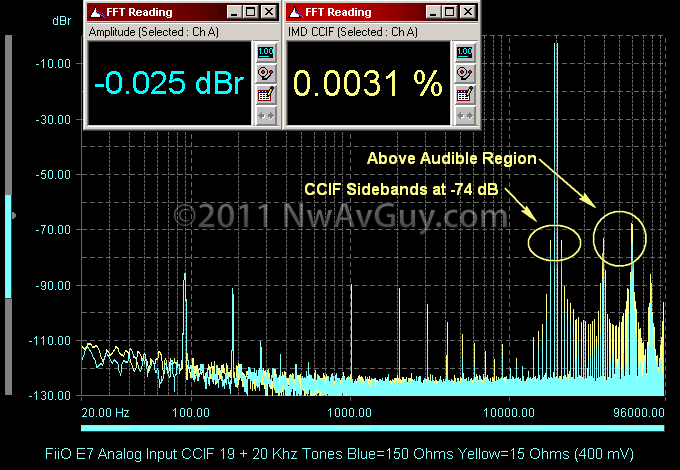
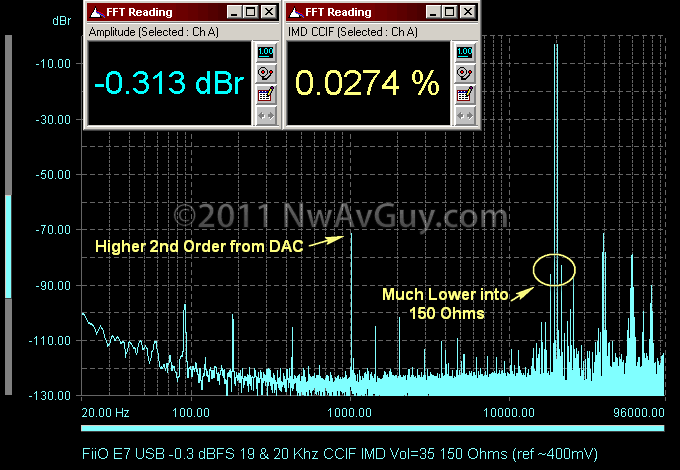
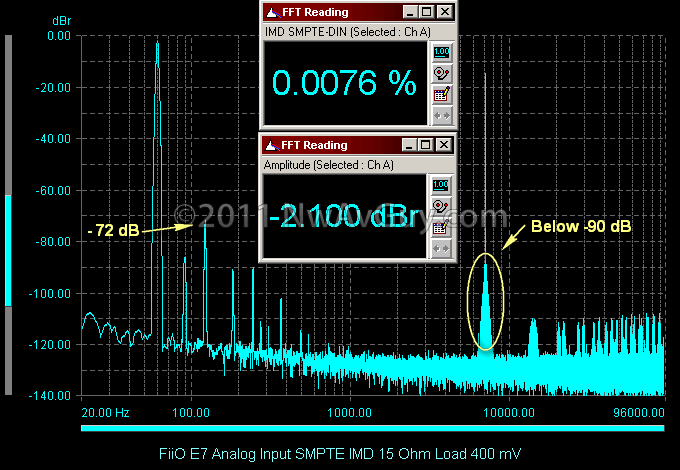

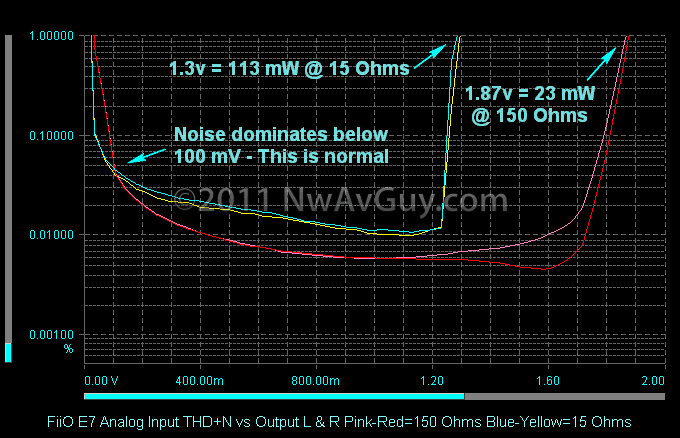
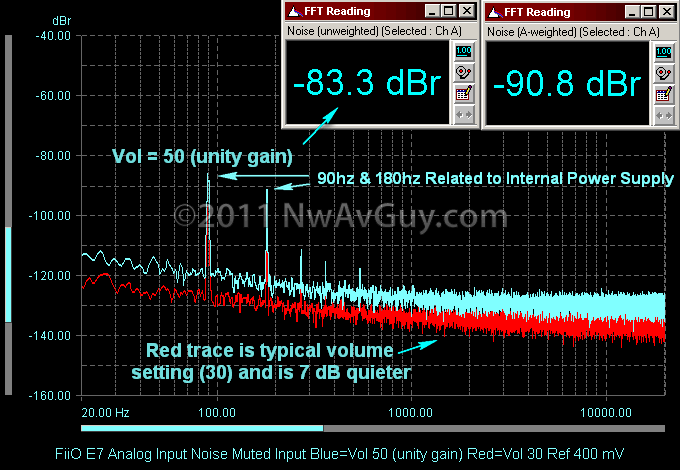

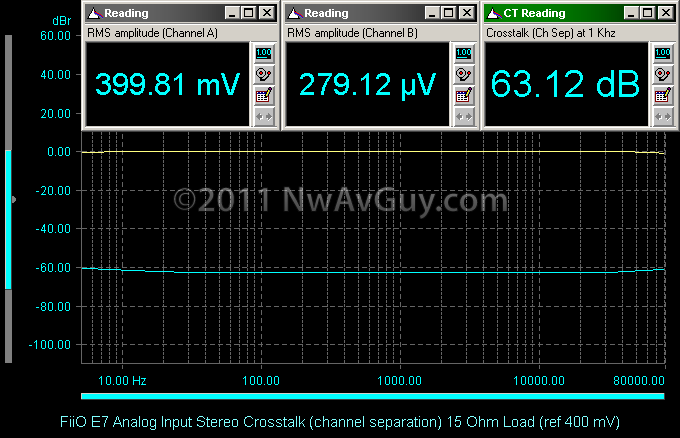


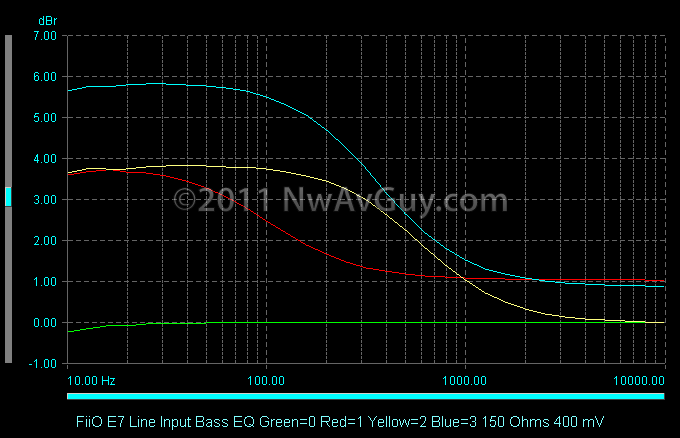
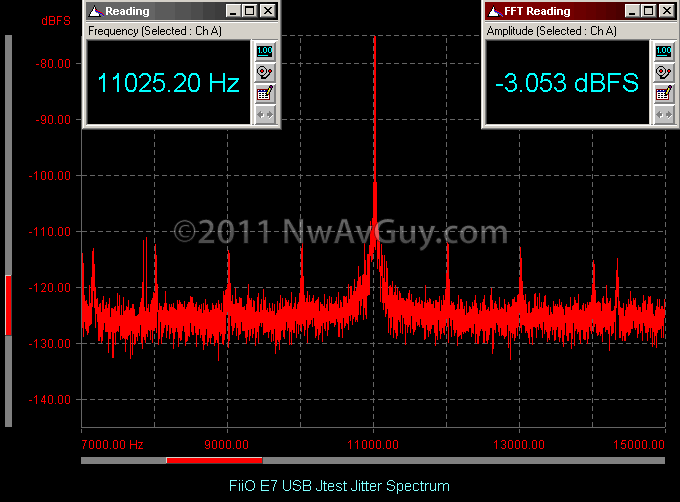
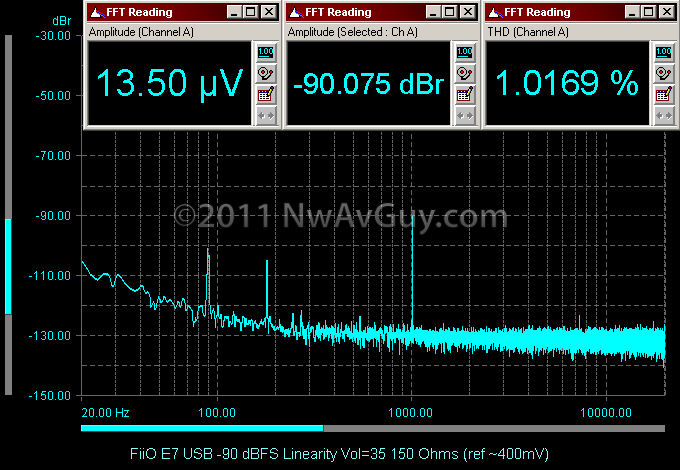
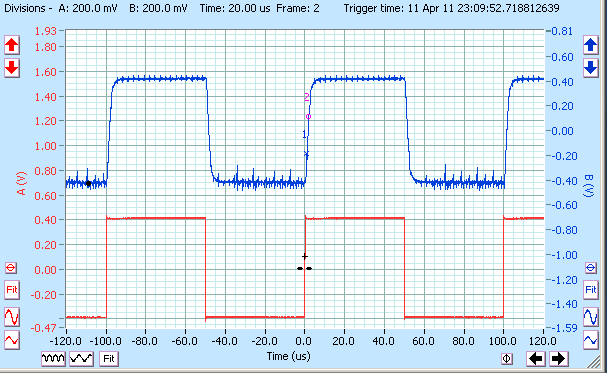
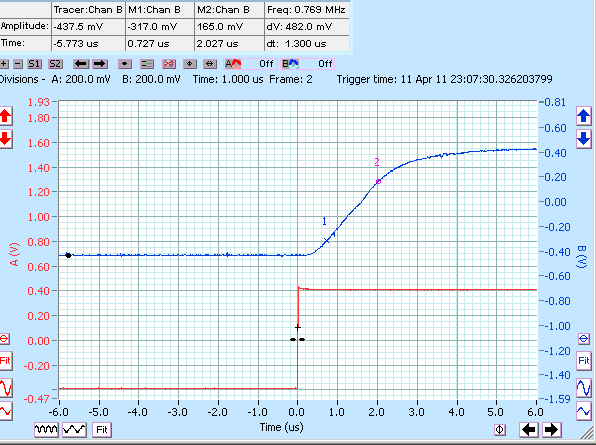

Thanks for the informative (and long, but I like that) review.
ReplyDeleteFiio claims to use a TI TPA6130A after the AD8692. Or at least, that's what's quoted on the Miccastore page you linked, and what's listed elsewhere.
That TI chip is the same that's used for the power stage of the E5. Looking at the spec sheet, it actually uses an internal charge pump, as you surmised. Actually, the volume control of the E7 and E5 look like just part of the functionality of the TPA6310A as well.
I didn't compare everything, but the max power output claimed by TI for that component is similar to what you measured for the E7. Unfortunately, it looks like giving it 5V rather than 3.7V will not make a difference in max output power for higher impedance loads.
You're welcome. And thanks for the TPA6130 info. My "forensics" were on the right track and I've updated the review. I should have caught that in the specs. The datasheet shows it will produce a bit more power with a 5 volt supply, but only below 20 ohms. So you're correct, it doesn't help where it's most needed.
ReplyDeleteawesome..
ReplyDelete..and why are you doing this for free ? :-)
A good sounding DAC is 99% science and 1% art. I'm trying to give the science a little more exposure.
ReplyDeleteThere's a serious shortage of decent objective data. And some manufactures have been less than honest with their specs and claims. Stereophile, for example, isn't likely to run Audio Precision measurements on a $99 DAC/Amp. But somebody has to publish the facts.
And, while I'm not opposed to being paid for the right gig, most paychecks have at least some commercial influence attached.
Thank you so much for your ongoing very informative blog-posts. I am a student and it is very interesting to see how you present hard facts and draw conclusions accordingly! One word: awesome!
ReplyDeleteEven more, because I intend to invest in "HiFi"-hardware at some near point in the future.
One question: I understand that the FiiO E7 has a fully fledged digital-analog-converter. Wouldn't it be "easy" for the manufacturers to add a regular digital input (S/PDIF) in addition to the USB-interface? Or would this require a sencond DAC (WM8740) in order to avoid some kind of multiplexing? This is a question I have nowhere found an answer up to now -- but you seem to certainly know the answer :-)
Thank you,
Peter
Hello NwAVGuy!
ReplyDeleteThanks a lot for putting so much effort in your reviews and tests. As a non-geek with a rather low budget I have been an enthusiastic reader of your blog. Please keep up! ^_^
May I ask if you intend to test the performance of the FiiO E9 and EMU 0202/4 USB any time soon?
Awesome Review! It's good to know that somebody is finally measuring all these devices, and that such an excellent device can be had for the price.
ReplyDelete- odigg
Glad you liked the article. Adding S/PDIF does not require a second DAC but does need more hardware. FiiO would have to add a digital receiver like the TI DIR9001. The DIR9001 handles the "multiplexing" as well as recovering the clock and data from the S/PDIF bitstream and converting it to a format the DAC can handle (I2S). For coax you need a somewhat bulky expensive transformer and optical requires an optical receiver and driver circuitry.
ReplyDeleteSo it's not hard, but it could easily make the E7 bigger and more expensive. And I'm not sure it would see that much use? What did you want to connect via S/PDIF? PC's are usually connected via USB and portables via headphones or a line-out cable.
If you're trying to get the digital signal out of an iPod, there are plenty of "iDAC" products but I think they're mostly a waste of money. The internal DAC and line output of a current generation iPod Touch are already very good. And it's hard for an external DAC costing a few hundred dollars or less to provide any meaningful improvement. Some, I suspect, probably even perform worse.
There are some inexpensive "no name" small DACs that have both USB and S/PDIF for around the same price as the E7 on eBay. But many do not have proper headphone outputs, and I'm not aware of any with battery power, bass EQ, displays, or the impressive industrial design of the E7. Plus, they're often "no name" products being shipped direct from China for a reason. I've encountered many with one or more serious flaws.
Highly interesting, as always on this blog!
ReplyDeleteYou're doing a great job in presenting the hard facts of the products you review, I only wish more people would have the same approach on the net.
I have a question though, is it possible to use this product with ASIO for bit-perfect playback?
Regards,
J. Petersson, Sweden
I don't think you need ASIO for "bit perfect" playback. Check the "Computer Audio Setup Guide" link on the right above. It explains how to get bit perfect playback in Windows and OS X using the built-in USB audio drivers.
ReplyDeleteASIO is generally used by professional musicians to reduce latency--the delay between recording and digital playback. But latency is not a problem for normal playback-only use as with the E7.
It should be possible for ASIO drivers to support a standard USB Class 1 audio device such as the FiiO E7 but I haven't tested it. To be honest, I've found ASIO drivers tend to create more problems than they solve unless you absolutely require minimum latency for live recording or some unusual application.
First poster reporting back.
ReplyDeleteIf you're considering suggestions on what to review next whenever you find the time and will, I am curious about internal sound cards. You've so far looked at portable audio players and external DACs, so this would be something new.
I'm thinking that the $30 Asus Xonar DG might be another strong budget contender, seeing as it's advertised as having a decent headphone amp. I would assume that Asus has the technical expertise and high volume of product to make a good budget offering.
With an internal card, +12V is available, so that makes supplying enough power for lower-sensitivity, higher-impedance loads easier. I think -12V is also available on PCI (not PCI-E), but do people actually use that?
Regards,
Mike
Hey Mike. I do plan to publish the results of some "built in" (i.e. what's already on the motherboard for laptop and desktop PCs) sound hardware tests. But I think high-end stereo PCI(e) soundcards are a dying product category.
ReplyDeleteThey were popular for 3 reasons:
1 - PC's didn't have any audio on the motherboard or it was really awful. But onboard audio is now universal and can be quite good these days.
2 - Until 1998 there was no reliable standard for high quality USB audio. And, until fairly recently, only firewire worked well for multi-channel audio at high bitrates. But that's all changed and USB works great now.
3 - Gamers often want multi channel audio and/or hardware audio features not well supported by some motherboard chipsets. It's all about special effects, and not dying in Worlds of Warcraft, not high quality stereo listening.
PC's are changing. A lot of the small quiet HTPC's used for A/V systems don't even have free PCI slots. Laptops, of course, don't either. Fast external interfaces like USB 2, USB 3, Firewire, and now Thunderbolt, are replacing all forms of internal PCI slots.
PCI soundcards usually require proprietary drivers. And those are often buggy and cause stability problems. USB audio has native operating system support.
And the inside of a PC is a REALLY noisy place for audio hardware. Modern CPU's draw nasty current spikes of 100+ amps with a broad spectrum of electromagnetic radiation. So any internal sound card is going to have to spend a lot of the hardware cost budget just fighting all that noise to improve upon what's already available on the motherboard.
So, for high quality stereo audio, I think internal soundcards are all but dead as a product category--unless you're a serious gamer.
Hi
ReplyDeleteJust wanted to leave you kudos on a job really well done on your reviews. I haven't really kept my hand in many headphones as of late and only recently learned of the existence of this blog.
The methodology appears to be pretty sound for the purposes of the reviews and I like the style of writing.
Thanks, and keep it up!
Cheers
bangraman on Head-Fi
Peter reporting back..
ReplyDeleteThank you for the instant answer and pointing me to that TI-chip.
You caught me... Why would I ask for a digital-input? I hope to buy an analog amplifier at some point. So -- how do you connect your digital sources (for example Logitech SqueezeBox, TV, BluRay-Player, iPod). Sure, all of them offer an analog output. But how well is the D/A-step performed in this hardware? Most of the modern hardware also offers a digital-output, which "should" be untouched and of high quality.
From all I read up to now there are pretty expensive solutions (Naim, Cambridge Audio, etc.), though the question arises how much you pay for the hardware and how much for the design/reputation...
Hopefully I could make my point clear (I am no native speaker).
Thank you very much.
I wish you pleasant day,
Peter
Peter, It sounds more like you need a preamp, amp, or receiver with several digital inputs? For BluRay most want multi-channel audio over HDMI. For a TV I don't think it matters much as most sources you play on a TV will be lossy compressed audio so a cheap A/V receiver, or analog output, is OK. I already discussed the iPod (which don't have direct S/PDIF anyway).
ReplyDeleteThat leaves the SqueezeBox. The DACs are quite good in some SqueezeBox players. I have a SlimDevices Transporter which rivals my Benchmark DAC1 Pre in performance. But even their less expensive models do a fairly good job (at least the ones designed by SlimDevices before Logitech took them over).
I agree for headphone listening from a network player like a SqueezeBox, a S/PDIF input on a DAC would be useful. For the rest, if you don't want to spend too much, I think an inexpensive A/V receiver with multiple digital inputs and HDMI is best--Yamaha, Onkyo, Denon, Sony, Pioneer, etc.
There are some reasonably priced DACs that can function as digital preamps with multiple inputs. But they still cost more than many A/V receivers.
There is less audible difference in sound quality than most people think between DACs. Have a look at the Matrix Audio Blind Test link on the upper right of this page. They compared a very cheap Sony CD player to a high-end Wadia CD player and none of the listeners could tell them apart. The Sony player, I'm sure, has a very cheap DAC--probably worse than you find in a Squeezebox.
I also plan to test some network players, including a few SqueezeBoxes, and publish the results here. That hopefully will help others decide if the internal DAC's are high enough quality.
Nice review as always. The E7 has been rocking on my work desk for a couple of months now. Ironically I didn't know about the volume changing bug until now since the volume is preserved through switching the device off and on. Regarding ASIO support, I can confirm it working via WASAPI, although I did not notice any difference in sound quality and turned it off.
ReplyDeleteAwesome review, looking forward to more reviews, I like the direction you are going in. Not many people can pick up difference in audio(sony vs wadia) but still sometimes it helps knowing that your audio equipment is up to notch.
ReplyDeleteThe question now is whether to go for this one or wait for the e11.
ReplyDeleteBefore your reviews, I used to think the uDAC-2 should be better than the E7 because it has better reviews on Amazon (which is intriguing to say the least).
ReplyDeleteSo thank you for providing us with such useful information (that unfortunately is so rare to find elsewhere).
Thank you very much for this, the one thing I would like to note as you mention the E9 desktop amp (that this unit docks to) has two headphone jacks; one 3.5 and one 1/4 (6.35) very handy if you have a pair of vintage cans.
ReplyDelete"reducing the volume in windows can also reduce the bit resolution"
ReplyDeleteI'm fairly certain (I'll dig up my refs from MS when I have a chance) this is not true in Vista or later - new stack does everything 32b FP internally, feeds soundcard/DAC with full resolution the card wants. This assumes of course you are not purposely bypassing the core of the audio stack and forcing things on purpose.
Rob
heycarnut you are correct... XP is the problem and lots of people still run XP. The "Computer Audio Setup Guide" link on the right of this blog has all the details including OS X.
ReplyDeleteSomeone pointed out via email I missed fully documenting the gain of the E7 so I've updated the review. Thanks for the correction.
ReplyDeleteThe E7's gain via USB is fine, but the gain using the analog line input is unusually low. That could be a problem for high impedance/low efficiency headphones and portable sources with limited output. See the article for more details.
Thanks for the informative review.
ReplyDeleteI'm a bit of a novice at this and I've been looking for a reasonably priced 2-channel USB DAC for my PC. I keep seeing the HRT Music Streamer II mentioned favorably. Would you consider it to be worth the extra expense over the E7 considering my only use will be for desktop speakers and not headphones?
Have you considered doing a review of the HRT?
Thanks for any advice,
Kyle
The HRT seems to be well designed and has the advantage of isolating the audio ground from the USB ground. The only complaint I've heard is that it has a rather "hot" output level (higher than normal). If you're going to connect it to something with a volume control (rather than just using the PC's volume) that shouldn't be a problem. It would be an interesting review.
ReplyDeleteThe E7 lacks a line output. So if that's your main goal it's probably not the best match. If you're trying to save money, consider the Behringer UCA202 which does a decent job via the line outputs.
Thanks for the quick response. A hot output won't bother me since it will be feeding a pair of M-Audio AV 40's. Not exactly high end, but I think they do a pretty decent job as PC speakers.
ReplyDeleteI did think about the Behringer but I just didn't think it would be as big a difference between that and the on board audio I'm using now as there would be going up to the HRT. Of course I may be totally wrong, like I said, I'm a novice at this.
Then again at that price point the Behringer wouldn't be that big of an investment to find out first hand. So I may go that route for now after all.
Thanks a lot for the advice and I look forward to reading more of your reviews.
Kyle
FiiO made the L7 'dock kit' which enables the line-out from the E7. It's about £15 (Amazon UK) at the moment.
ReplyDeleteThanks for the info NullZero.
ReplyDeleteThat's making me reconsider. I may get the E7/L7 combo unless there's some other reason that I should reconsider. This is of course assuming I can leave the E7/L7 constantly connected to the PC and that it can be powered by the USB connection.
Sorry NwAvGuy for hijacking the comment section.
Kyle
NwAvGuy, I'd very much disagree with internal soundcards being a "dying breed". They may be needing proprietary drivers (which have proven a trouble spot in the past), but so do USB devices with asynchronous transfers, e.g. EMU 0404 USB.
ReplyDeleteExternal sound interfaces also tend to incur a lot of overhead (regardless of USB or IEEE1394), not to mention the mess that sample rate switching can be. 10 years ago, it was normal for soundcards not to give more than 1..2% of system load, or at least firmly in the single-digit % territory - on a PIII-500.
To see what an internal card at consumer level can do, I'd suggest you try a Xonar D2/D2X or D1/DX.
Re: "dying breeds", people have claimed that desktop PCs were one for years. Nowadays we have a lot more formfactors to choose from, depending on the application, but did desktop machines disappear? Certainly not, and for good reason.
One little detail I noticed in the article:
Your E7 THD vs. output plot has linear scaling on the voltage axis, vs. the standard (and better-suited) logarithmic one.
Stephan, thanks for the comments. I agree about the log axis. I've been refining my data presentation as I go. Some of the dScope defaults are not ideal.
ReplyDeleteAs for sound cards, I stand by my "dying breed" comment. For anything but video boards, I think internal slots are old school technology that's no longer needed with USB 2.0, USB 3.0 and Thunderbolt. The extremely noisy environment inside a PC is a poor location for any high-end audio device.
Drivers continue to be a problem as few companies take the time to get them right. They quickly shift their development resources to the next new product. I agree even USB drivers can be buggy (mine are for my E-Mu 0404). That's why I favor USB devices that have native operating system support.
As for "asynchronous transfers" that's a topic of a future blog article I'm working on. It's a confusing and somewhat mythical area of PC audio. Changing the USB transfer mode doesn't magically solve the clock and jitter problems like some think it does. And some products use Asynchronous Sample Rate Conversion to remove jitter--like the Benchmark DAC1--and that has nothing to do with the USB interface.
I can understand using soundcards for gaming--especially when you don't want any external devices. But they're far from ideal for high-end 2 channel audio. And, increasingly, there won't be any slots to plug them into.
Perfect parameters doesn't matter.
ReplyDeleteSound from FIIO E7 is awfully washed out. It reminds me sound from cheap Japanese equipment 20 years ago.
I can blame "to perfect" AD/TI opamps or some stupid volume regulator for this - even when I use E7 as a amp, sound became awfully damaged by electronics of E7 and E5 do exactly the same.
My SB Live USB with SigmaTel and cheap TDA1308T opamp after my few modifications sounds much better, more natural, more dynamic, acoustic.
E7 has a technically perfect sound but without a life. Sorry.
Buy something without digital volume control, without opamps.
Borizm, you need to experience a real blind test. See my new Subjective vs Objective article. I've done blind testing with the E5 and you would be surprised how hard it is to tell apart from other headphone amps.
ReplyDeleteHey NwAvGuy, thank you for the detailed review.
ReplyDeleteI was wondering if you could inform me if the performance I am experiencing from my E7 is normal or not.
Firstly, there is a noticeable popping/clicking noise when I adjust the volume. I assume this is because it is a digital volume control?
Also, changing the bass boost function sometimes makes a buzzing sound, which gets more prominent if I change it repeatedly.
Finally, my E7 actually performs better with usb charging on (when I use it as a DAC). When I have charging off, there is a noticeable, annoying, buzzing sound that accompanies high-frequency sounds. However, with charging on, this sound disappears completely.
So, is this performance normal compared to your experience? Or have I received a defective model?
Thanks for you help, and for the review, I appreciate the effort that goes into a review as technical as this. Although I probably struggle to understand a lot of the information, what I do understand is very helpful.
I don't think any of that's normal beyond perhaps a very slight "tick" when changing volume. It might depend on how sensitive (efficient) your headphones are. But it sounds like something might be wrong with yours. I never heard any buzzing sounds of any kind.
ReplyDeleteFiiO's quality control is apparently a bit sloppy as my E5 has a fairly obvious problem that's not normal. And I've heard of a few other people who received FiiO products that worked but had to be returned for some problem with the replacement being OK.
Mine seems to work fine and produce perfect quality when playing music through usb and analog, but i did notice that when leaving the fiio e7 on loud volumes 40 and above and leaving the little analog wire attached if you touch the gold tip it will make a buzz noise just like my electric guitar expensive tub amp. i noticed same mini sound when plugging it into my sansa clip for a split second then all went to perfect silence and plays perfectly still. when pushing it past 43 it makes noticeable clicking sounds only when changing the volume too with my superlux hd668b. these may be simularly sensitive like his headphones. but after volume is set it all seems normal. since i am used to these things with my instrument amplifiers i actually ignored these factors and thought it was normal for high end amplifiers to do that. i mean if i touched the input wire of my dads high end yamaha amplifier upstairs with my finger or toung i am sure it would buzz too. i feel the buzzing when playing with the analog wire not plugged into a device and just being amped by the e7. but is the clicking normal when changing the volume for an e7 when pushing sensitive headphones past 40-43 with probably a slightly less sensitive then desirable analog input device like my sansa clip. since you said the gain on the analog side is a bit weak so i am assume with a more powerful input this would probably not be a problem. or do you think i should get my fiio e7 replaced? it seems to work perfectly to me other then that.
DeleteWow, NuForce hater! I love it. What do you recommend for a $100 headphone dac/amp? Please keep up the great work.
ReplyDeleteYou don't like the E7 for some reason? There are not many portable DAC/Amp combos around $100. The Leckerton UHA-4 might be worth a look. If it doesn't have to be battery powered, I've had some requests to test the Creative X-Fi USB headphone DAC which is around $100 but I have no idea how well it really performs (especially the headphone output).
ReplyDeletehello
ReplyDeleteis this thing likely to make any difference to lower quality (aac 128 etc) youtube video/audio/music files played on a laptop through heaphones as opposed to higher quality flac or wav copied from cd (garbage in garbage out etc)
AAC 128 can sound pretty good. But, in general, if the laptop doesn't have any obvious problems (i.e. no weird background noises, it will play loud enough with your headphones, etc.) then an external DAC like the E7 probably won't help much--especially playing relatively low quality content.
ReplyDeleteThe DAC itself in laptops is usually halfway decent these days. It's usually what comes after the DAC that causes problems.
Hey NwAvGuy-
ReplyDeleteHow come you're not putting this stuff up on Head-Fi? I was just checking in because I haven't seen you there lately. Keep up the EXCELLENT work- you are my reality check! =)
Dear NwAvGuy,
ReplyDeleteHow do you think about additional upgrade in FiiO E7: change of AD8692 to THS4222?
mikeK, Glad you like the blog. I don't put things on Head-Fi because, after I gave a negative review to a Head-Fi sponsor (NuForce), Jude just deletes anything I post there that even mentions this blog.
ReplyDeleteAs for the AD8692, based on what I've seen, the implementation of a DAC chip usually makes a bigger difference than which DAC chip. The best DAC chip on the planet will perform worse than a lowly PCM2706 if you even route the ground pins wrong on the PCB.
ReplyDeleteThe NuForce uDAC-2 is a perfect example. It uses a great DAC chip but NuForce did a lousy job implementing it resulting in high distortion and high jitter. The lowly Behringer UCA202 measures better in many ways.
Product mods are often done by people with less product knowledge, and fewer ways to verify the performance, than whoever designed the commercial product. As a result, their results are often inferior to the original design. But, using only subjective biased listening as their guide, they hear what they want or expect to hear.
The DAC is not the limiting factor in the E7. The E7 is far more limited by the TI output "chip amp" that drives the headphones and the 5 volt USB power supply.
Thanks for the review, great to see some lab data. :)
ReplyDeleteDo you think that the E7 would be able to satisfactorily drive my Sennheiser HD600's?
As a grad student the price of the E7 and the DAC/Amp combo hold a lot of appeal ...
You're welcome. The answer on the HD600s is it depends on what music you like and how loud you want to listen. The E7 can manage about 1.9 volts of output into the HD600s which is about 12 mW at 300 ohms. The HD600s are rated at 97 dB with 1 mW and you'll get about 11 dB more at 12 mW. 97+11 = 108 dB SPL. The general rule of thumb is around 110 dB so it's close.
ReplyDeleteBeing loud enough is a subjective issue so it's hard to say. But the flipside is not many battery or USB powered headphone DACs are likely to have much more output than the E7.
The good is, even if it's not quite loud enough for your tastes, that at least might help preserve your hearing ;)
Heh. :) Thanks for the quick reply.
ReplyDeleteI listen to a range from classical (esp. Mahler and Schoenberg) through some rock and metal, a lot of minimal techno/electro, and plenty of yacht rock/baeleric stuff like Steely Dan.
It's a hard call. Do you already have the HD600s? If so, what are you driving them with now and are they loud enough for your tastes?
ReplyDeleteIf you don't have them yet, you might want to buy the HD600s first, try them with whatever sources you have (ideally something with a well known maximum output), and that will help answer the question if the E7 has enough beans.
Yeah, I have them and am listening to them from my mp3 player, which is only just loud enough to be enjoyable. Unfortunately the only info I can find on it states a headphone outfit power of 30mW (no load impedance given with that figure).
ReplyDeleteI find the output from my laptop to sound pretty "rough" and it can't match the required levels when the music level increases dramatically.
The mp3 player is a creative Muvo2 btw.
ReplyDeleteHmmm... My instinct is the E7 might be marginal for your tastes. You might want to, if you haven't already, search the usual sites for other users who might have that combination and ask if they're happy with the max volume.
ReplyDeleteOf, if you can buy the E7 somewhere with a generous return policy, that would let you try it out for yourself with minimal risk.
If this is mainly for home use, and you're OK using line power, there are some better options for around the same money. But if you want something USB/battery powered, I don't have any obviously better suggestions besides perhaps the Leckerton UHA-4 but it's gone up in price so it's not the bargain the E7 is.
Have found some happy E7/HD600 users online, but it does seem a bit marginal. Having the DAC and amp outside my computer is tempting though. Especially for the price ...
ReplyDeleteIt will be for home use only, as I don't intend to take the HD600's outside. If you have any DAC/amp combo suggestions around that price I'd love to hear them. :)
You can, of course, start with the E7 and, if it's still not quite loud enough add the E9 later. The combined price isn't that much more than the Leckerton and the E9 is much better suited to voltage hungry high impedance headphones.
ReplyDeleteThanks for all the advice - much appreciated!
ReplyDeleteAmazon had a good deal on the E7 (~$75 incl. shipping), and UK distance selling regulations entitle consumers to return goods without any reason (within 2 weeks).
So, E7 is ordered. Hope it does the trick! :)
Great work. If only more people cared to review audio hardware in such an analytical manner instead of the usual audiophile mambo-jambo.
ReplyDeleteI'm very interested in E7/L7 combo. I doubt I could hear much difference between Fiio and anything else I could potentially afford (but certainly not justify) buying:)
Hi! I have a iphone 4 and shure se115, grado s80, akg k 518 dj. When i us iphone the volume is loud enough, will i have a better sound if i have a E7 or other amp?
ReplyDeleteAnders
The iPhone4, if loud enough, is a good source. You don't need an amp. Just enjoy!
ReplyDeleteBTW, will give my comments on the E7 next week.
ReplyDeleteSo far it's a definite improvement over motherboard/laptop/mp3 player, and I am getting a lot of pleasure out of it. Lacks the juice to really drive Sennheiser HD600s on tracks that need more gain though.
With the Columbia C2K 36183 version of Pink Floyd's The Wall it's almost there. With a better amp I'd be quite happy with the Empty Spaces/Young Lust segue. ;-) With the MFSL version it just doesn't have the juice ...
Hi NwAvGuy!
ReplyDeleteMate, I have been reading your thread for about 3 days now (Head-Fi member myself), and I have to admit that I really admire your passion and intelligence when it comes to audio engineering and the way you present objective arguments into the picture. I do have a question and hope you can answer.
I am interested in buying the Denon D7000, and with the change, I am looking at the E7 as a cost-effective way to drive the Denons for the time being. I keep hearing that the Denon requires an amp that can drive low impedance phones well. Here are the specs.
Impedance @ 1kHz: 25
Sensitivity: 106 dB/mW
FR Graph: http://bit.ly/n5l3kI
Would you consider the E7 to be a capable amp? Or am I wasting my time, and just go for a desktop SS amp? I can appreciate your insight with this.
Thanks again, and appreciate your contribution within this hobby/industry.
Michael
I have the fairly similar Denon D2000s and I think the E7 does a nice job with them. It has plenty of power for their impedance and sensitivity.
ReplyDeleteThe "chip amp" in the E7 isn't high-end but it's respectable. If you want a DAC, and something that's portable, the E7 is hard to beat for anywhere close to the price. If you just want a desktop amp to use with another source, it might not be the best choice.
Thanks for the prompt reply mate.
ReplyDeleteYes, I see the D2000/D700 share same specs. I believe the only difference is the size of the magnet on the D7000 and the luxury benefits.
I'm close to buying the E7, as for the buck it seems like a steal, and would accompany my 2010 MBP well design wise.
You've given a definitive review here. I'll be following your blog from now on. Cheers
Bro great review you got here, very in depth and lots of info... i recently got the E7 mainly for my portable stuff, but i was wondering, will it be better if i add the E7 to my current home setup which is - macbook pro-itunes-digital out via toslink - kenwood 7.1 receiver-wharfedale speakers?
ReplyDeleteI will use it for audio listening so it will be macbook-E7-L7-kenwood-wharfdale speakers
thanks in advance :)
Toslink into your Kenwood is fine. I'd stick with that and use the E7 on the go.
ReplyDeleteThanks for the quick reply, does that mean i don't get any benefit with using the E7? Just bought the L7, i should have asked sooner here to save me some money :)
ReplyDeletesorry for such a newbie question, just starting on this new hobby, thanks again :)
-dens
The E7 makes a decent portable amp even if you're not using the DAC. You can also use it, via USB, with your Macbook if you want for headphone listening. But for listening over your speakers, the Toslink connection is fine.
ReplyDeleteIf you want to hook an iPod or iPhone to your home system, you can do that directly from the L7 to one of the analog inputs on your receiver.
okay got it, was hoping my speakers would also benefit from the E7, hehe :)
ReplyDeletethanks again for your advice, really really appreciate such help
-dens
Hey,
ReplyDeleteFirst off, nice blog. I'm a scientist who also happens to really like music, and I've long been looking for objective audio tests and measurements; so, I'm very glad you've taken up the mantle! I look forward to your future entries regarding other audio gear besides headphone amps.
Now, on to my question: you state here in the E7 review that the E7's jitter performance "is significantly better than the...UCA202." However, from the jitter spectra you show, the UCA202 has only two jitter sidebands, and they're 8 or so dB lower than those in the E7. Similarly, the low-frequency spread also appears to be ~10 dB lower in the 202 than the E7. The widths of the main peaks are a bit hard to compare since the frequency scales are different. So, am I missing something? Because it looks to me like the 202 outperforms the E7 with respect to jitter. Any insight you can provide would be appreciated.
By the way, the reason I'm asking is because I'm looking for a reasonably priced USB or Toslink DAC for a computer audio setup, and those both seem like good candidates; that I could use them with headphones, too, is a nice bonus. I'm curious about the FiiO D3, too. It's funny, but I was considering the NuForce when I noticed the odd notes on their website about its performance. That lead me to your site.
Thanks again for all your work. The O2 looks interesting, by the way. If I needed a headphone amp only, I'd definitely try to get my hands on one. And one other thing: I tried using the Contact link on the right on three different browsers multiple times, and every time I got a message saying I had entered the wrong character code. Not sure what's going on, but I don't think I'm that bad at character recognition....
Derek, thanks for the feedback and encouragement. It looks like you have a valid point on the E7 vs UCA202 jitter. The "spread" (low frequency jitter) is wider on the E7 which is likely why I concluded it was better, but on looking at both plots, the frequency spectrum is different. Given that, I would say they're relatively similar.
ReplyDeleteThe PCM2xxx chips, as used in the UCA202 and lots of other USB DACs, are not known for especially low jitter. They're relatively cheap and easy to use which makes them rather popular. But they're also a relatively old design. And, apples-to-apples, if you compare any PCM2xxx USB interface to say the Benchmark DAC1, the DAC1 wins by a huge margin. How much of that is audible is less clear.
I'd have to go back and look at my test notes, but originally I just used a conventional sine wave tone for the jitter tests. And, I think, the E7 used the JTEST signal which is substantially more jitter prone. You can Google JTEST JITTER to find more. But one of the employees at Prism Sound--makers of the dScope analyzer I use helped develop the JTEST and there's an AES paper on the topic.
I keep making minor updates to my testing methods as I get feedback from others on ways to do it better. The result, in this case, is the jitter tests between those two DACs were not done the same way. I realize that's less than ideal, but having just started this blog earlier this year, the UCA202 article was a very early review. My methodology has improved and is more stable now although I'm still making minor tweaks based on feedback.
As for USB DACs, many have asked for a reasonably priced DAC to pair with the O2 Headphone Amp so that's next on my test bench. The Asus Xonar U3 and Creative X-Fi HD are the first two I'll likely review. If neither one of those has respectable DAC performance the search will continue.
Ah, I overlooked that you were using different inputs for the jitter tests. Makes it difficult to compare the spectra directly, then. It would be interesting to see how the UCA202 does with the jtest signal (you know, in all your spare time...).
ReplyDeleteThanks for the DAC leads. Have you looked at the FiiO D3, by any chance? It's got a Wolfson WM8805 in it. Assuming a reasonable implementation, how do you think that would compare with the PCM2xx chips? (I realize the D3 is S/PDIF and not USB.)
I haven't looked at the D3. While I can see a few isolated good reasons for a S/PDIF DAC, that doesn't include using a USB to S/PDIF converter. The more "boxes" you put in the audio signal path generally the worse the performance.
ReplyDeleteA USB DAC can easily outperform a 2 box solution using USB -> S/PDIF -> DAC. It helps a lot when one designer/company can use the superior I2S bus internally and make sure everything is designed to play nice together without introducing yet another source of jitter (i.e. every S/PDIF connection).
If someone has a really lousy network music player that happens to have an S/PDIF output, then I can see perhaps using a S/PDIF DAC as an upgrade. But most of the other applications are better addressed in other ways.
I was really impressed with the FiiO E5 and E7 for their respective price points. They're well made and a lot of value for the money. The E9, and now the E11, however, give me reason to believe FiiO either isn't as competent as I thought or mainly interested in chasing audiophile myths and fads.
The output impedance of the E9 is disappointing from it's 1/4" headphone jack and really poor from the 1/8" jack. It also has alarmingly high levels of low frequency distortion. And E11 is essentially a copy of the highly flawed AMB Mini3. FiiO, for reasons I don't understand, copied the Titanic complete with the big gaping hole in the side (the OPA690 virtual ground).
So I'm really not sure what to make of FiiO these days. I had high hopes they were on the road to "best performance per dollar" but they seem to be going in other directions with some of their newer designs.
There wouldn't be a USB to S/PDIF converter; I can get S/PDIF out of my computer directly. That's why I'm interested in either a straight USB DAC or S/PDIF DAC, whichever gives the best performance per dollar, as you put it. That's why I was wondering what you thought of the WM8805 vs the PCM2xx. The DAC would feed into active speakers for listening while I'm at the computer, no network players or home systems involved. At least, that's the current plan.
ReplyDeleteThanks for the prompt reply!
On paper (i.e. datasheets) the WM8805 beats the PCM2xxx. But, as the O2 amp demonstrates, the implementation is everything. NuForce, for example, uses a great DAC chip in the uDAC-2 but they completely screwed up the implementation to where the far less expensive UCA202 out performs it in several areas.
ReplyDeleteSo I'd have to test the D3 to really know. And given the limited appeal of a S/PDIF DAC, it's not that high up on the list. But stay tuned for other USB DACs reviews.
Indeed, I realize the reasonable implementation assumption is a big one. Thanks again for your feedback, and I look forward to your upcoming reviews.
ReplyDeleteCheers!
I should also point out using S/PDIF out of your computer puts you at the mercy of the sound hardware in your PC. The S/PDIF output could be heavily jitter prone for example.
ReplyDeleteBut a USB DAC bypasses all the hardware in your PC without needing proprietary drivers. It's a very "pure" self-contained solution. And it's far more reproducible. A USB DAC is more likely to perform similarly on different PC's than a S/PDIF DAC.
Excellent points. A USB DAC it is, then.
ReplyDeleteAWESOME review!
ReplyDeleteThis is the kind of review you would wish the guys who are actually getting payed for it, would take the time and effort to do.
I am really interested in getting one of these little gadgets, but I don't know if it would be able to handle my Ultrasones. I have two pairs, with 64 and 70 Ohms respectively (DJ1 Pro & HFI 2400).
I also read your articles "Headphones and Impedance" and "Headphones Amps/DACs explained", but got a little confused, since you pointed out that headphones with lower Impedances won't really see much benefit from Amps, and that DACs can sometimes cause more problems than they solve (for various reasons), as well as that they don't necessarily mean huge or noticeable improvements in sound quality.
I use both my headphones with my iPod touch (current generation), and I am pretty ok with the sound and the volume, but I also know my headphones can give more.
My goal in getting an Amp with DAC is to improve sound quality and to take full advantage of the quality of my headphones when it comes to detail and a wider soundstage.
I've never owned a headphone Amp nor an extra DAC, and I have only had the chance to hear Headphone Amps a couple of times -and not with my own Headphones- and I thought this very affordable FIIIO E7 could be an economically benign entry point to see if it's really worth having one.
I hope I'm not being to basic here or failing to get the point in your very well written and extensive articles, but I'm pretty new to these kind of products or giving an extra thought to improving the sound quality of my headphones beyond the obvious.
Great blog, will definitely continue enjoy reading.
THX
THX, The key thing in your comment is "I am pretty ok with the sound and the volume". The 4G Touch has a suitably low output impedance. And it has great specs in terms of noise, distortion, etc. That means if your headphones get loud enough now, I wouldn't bother with the hassle and expense of an amp. It might be hard to believe, but an amp can't improve the sound beyond making it even louder or possibly preventing clipping on some peaks.
ReplyDeleteThe amp/dac and impedance articles are some of my earlier efforts and need some work. So don't worry you're missing something. I need to clean them up and update them.
Unfortunately, it's kind of a complex topic. And it's made worse because manufacture's data is often not available, or even when it is, they present it in different ways. Sennheiser rates some of their headphones in dB SPL at 1 volt for example and others at 1 mW which are entirely different. Some even just give a dB number with no level at all which is useless as you're forced to guess.
This is important because it's not just impedance that matters, but also sensitivity of the headphones (their efficiency as in how many dB SPL you get with 1 mW or some other known amount of signal level). So I would have to know your Ultrasone's sensitivity to know how loud they would play on your iPod compared to the E7.
There are some relatively low impedance headphones, like the Audeze LCD-2, HiFiMan planars, AKG K701, etc. that need quite a bit of power and will generally require an amp--and even many amps are not up to the task.
The point I was trying to make in the article is if you have 16 or 32 ohm headphones designed mostly for portable use, it's likely they don't need an amp. Some fall into a gray area like the 25 ohm full size Denons or my 80 ohm Beyers. But, utlimately, it comes down to quality of the headphone amp built into the device and if they'll play loudly enough without an amp. That's really a matter of individual preferences, types of music, and how much hearing damage you'd like to sustain for who like it really loud.
Thanks a lot for your detailed and quick answer, NwAvGuy, I appreciate it.
ReplyDeleteSince I'm new to headphone amps and Amp/DACs, I'm basically curious to know how much improvement my already fairly expensive headphones can really offer with an Amp/DAC such as the E7.
Im not really interested in merely pumping up the volume, but to hear more detail and a wider and more accurate soundstage.
In the case of using the E7 only as Amp and portable device for on the go, the result would be volume, but how about the sound quality when used on my
laptop or with another source that will take advantage of the DAC? Will the
results go beyond a mere increase of volume, and will I actually be able to hear
something qualitatively different?
Regarding the sensitivity of my DJ1 Pro's, I have read two reviews (unfortunately no way near the quality and detail of yours) that underline that there's no need
for a headphone Amp, and even one that says that, according to the sensitivity
ratings of the DJ1's, they would be in no need for an Amp, but fails to quote any
exact figures or measurements. Ultrasone provides only the minimum of info on
their headphones, and even omits important details regarding the differences
between them.
This is what you get:
Technical specifications
S-Logic Natural Surround Sound
Dynamic principle
Frequency range: 10-22,000 Hz
Impedance 64 Ohms
Sound pressure level: 102 dB
MU Metal bufferboard, reduced field emissions in accordance with ULE (=Ultra
Low Emission) standard
Driver: 50 mm Mylar
Weight: 295 g (without cord)
Long-term availability of spare parts
In the case of the HFI 2400, I found no references regarding sensitivity or their use in conjunction wit Amps or DACs.
I hope I'm not being merely insistent, and that my questions don't all fall into the iobvious.
Regarding the senditivity of my Ultrasones, unfortunately
That 102 dB in the specs is probably the sensitivity at 1 mW. Which means they will indeed get plenty loud with a Touch 4G. You absolutely don't need, or want, an amp with the Touch and those cans. As for your laptop that really depends on the laptop and they cover a wide range for sound quality. My best suggestion is to play the exact same demo material, at the same volume, on both the Touch and the Laptop. If, being as unbiased as possible, it sounds very similar the laptop is fine as is. If you notice significant differences, weird noises, etc, then the E7 would likely help. Let the iPod Touch be your yardstick as it's a proven performer.
ReplyDeleteTHX again for your answer, NwAvGuy.
ReplyDeleteI Will definitely consider your advice.
First of all, I'll say I love your blog. I learned so much from reading your articles "Headphones and Impedance" and "Headphones Amps/DACs explained".
ReplyDeleteI'm looking for a portable amp for my Beyer DT770 Pro 80's and I was hoping that the E7 would be a good match but I see that it doesnt quite have enough power to drive them. I am using an iPhone 3G as my source and I would like to get something with less output impedance to tighten up the bass a little bit and give me more volume. I asked the Head-fi community for suggestions but after reading your blog post about that whole fiasco, I'm not sure I'll be going back in there, nor do I trust their opinions. Can you make any suggestions? Also, a DAC is not important to me, but I'll purchase whatever, as long as the amp is good. Thanks in advance and thanks again for these great blog posts.
blahblah, glad you got something out of my blog. I'm still working on updating the articles you mentioned as they're very early articles here and still need some work.
ReplyDeleteIf you're iPhone is getting reasonably close to loud enough with the DT770-80's you probably would be happy with the E7 or, save a bunch of money, and just get the $20 FiiO E5 which uses the exact same headphone amp. Both have the same "near zero ohm" output impedance which should tighten up the bass a bit with your Beyers.
I own the same Beyers (as you I'm sure you read) and have used them on my Touch 3G which is similar to the iPhone 3G for headphone circuitry. I can attest the E5 does help them play louder with slightly better bass performance with no unpleasant side effects. The battery life isn't as good as the E7, but it charges quickly and you can use it while it's charging.
Another option might be to wait for a commercial (or at least no-soldering kit) version of the O2 Headphone Amp. Or you get the E5 for now and if you decide you want even more power, get the O2 later.
Thanks for the advice, I probably will get the E5 for the time being. The 02 your speaking of, this is the amp you're making, correct? How long til we see a commercial version? I would definitely buy one because I love what you have brought to this community. I'm new to this hobby and would have probably fallen victim to all the subjectivity and purchased a $200 iBasso Mamba if I hadnt stumbled across your blog which explained everything I needed to know to realize what a scam some of these products are. Keep up the great work, and thanks again!
ReplyDeleteI have an USB dac (as well as the Matrix desktop amp, essentially a Lehmann BCL clone) but that setup is tied to the desk. Now I am wondering whether I should get an E7 for traveling or wait for the E17 (better DAC, better Amp)... How well does the Line Out from the Dock perform (if you ever tried that)?
ReplyDeleteI will mainly be driving IEMs and my D2000, so low gain is a blessing rather than a curse.
Thanks for the quick reply, really appreciate it.
ReplyDeleteThat sounds good, I dont think I really need 96/24 so waiting for the E17 might be pointless. The other option would be to go for a 5.1 USB card because so far I do not have a HDMI compliant receiver (but 5.1 boxes) in my living room but I think I will simply upgrade that receiver in due course to be able to hook up my laptop to it.
As for the amp, I think I read some rumors that they will go for an TPA6120 in the E17 but that seems like a pretty power hungry approach to me. As for truly power hungry cans, I think my MStage on high gain has even been used with LCD-2s with satisfying results and that is about as power hungry as decent gear gets... My desktop DAC has insanely high gain (to the point I cannot use the integrated amp with the D2000 without suffering of channel imbalance) and runs too hot, so I would rather like to get rid of that thing altogether :P
BTW, I just read on head-fi (from FiiO employee) that the E17 has the same AMP as the E11 and considering you consider that to be a deeply design waiting for that seems kinda pointless...
ReplyDeleteHey, Great review!
ReplyDeleteI just wanted to know if you would recommend the E7 over the behringer uce202 with a FiiO E5.
Thanks!
The E7 is certainly more convenient and has some nice extra features, longer battery life, etc. It's hard to say if it will sound any better (ignoring the added EQ options on the E7). I'd much rather carry around one device rather than two.
ReplyDeleteActually, the UCA202 and E5 might be a bad combo. The UCA202 line outputs might overload the E5's input so you might be forced to use the headphone output of the UCA202.
ReplyDeleteThank you for the review. When comparing UCA202 and E7 solely as a DAC which would you say is better? Regarding the UCA202 output overloading the E5, what kind of output does UCA202's line out have? Also the E6 is now available, which looks like it can accept higher input signals than the E5 http://tinyurl.com/3zujcbe.
ReplyDeleteDo you have any plans to review the Fiio E6 and E11?
Hey Daniel. I probably won't be reviewing the E11 as it's essentially a Chinese copy of the heavily flawed AMB Mini3 with a different battery scheme.
ReplyDeleteThe E6 and D5 are more interesting. I think the E7 has the overall edge on the UCA202. I don't remember off hand the output of the UCA202 line outs, but it has to be under about 1.4 Vrms as that's about the most you can get from "raw" USB power.
Thanks! Cross E11 off my list.
ReplyDeleteI am actually considering purchasing an amp(possibly portable) for use with my iPhone4 and ATH-M50(38 ohms, 99dB). I assume there would be SQ improvement with an LOD vs Headphone out of the iPhone4. Would you say that is true?
I am was considering the E6 and E11 fed through LOD from iPhone 4. Currently iPhone 4 HO sounds good and has enough volume just wondering if there is more SQ to be squeezed out with an amp.
Also considering more of a desktop setup instead. (originally considering E9, but thats out due to output impedance). I may consider the O2 as well.
Daniel, I'm not sure you would hear a difference in a blind test. The iPhone4 has a low output impedance and supposedly very good performance. If it's close to the Touch 4G I would say you don't need any outboard amp with those headphones. Any benefit in SQ will likely be more imagined than real.
ReplyDeleteThe Iphone 4 has the lowest output impedance from an Apple DAP I've seen at 0.9. Supposedly the 4G Touch has a high output impedance at 7 ohms (which is proven by the Markus Kraus graphs).
ReplyDeleteThanks for the info. Any plans to review the Fiio E10? It has a positive review from Headfonia as being better than the E7. Output impedence is also <1ohm. Any comments on it's design(is it flawed like the E11?)?
ReplyDeleteYes I probably will review the E10 once it's generally available in the USA. My main interest is in the DAC as it supposedly uses a Tenor USB interface to support 24 bit audio over USB. I'm not sure about the headphone amp. I've read it uses the AD8397 just like the E11 but I don't know if it uses a virtual ground like the E11 (and Mini3) or a true bipolar power supply. It might be an E11 with a DAC added or we can hope FiiO didn't make the same mistake twice.
ReplyDeleteThanks for the unbiased and data-heavy review - picked the E7 because of it and love it so far. I got the E9 bundle and like you, am disappointed the bass boost gets disabled when docked. I'll be honest...with my Grado SR80s, it's hard to tell the difference between the E7 on its own and the combo with the E9.
ReplyDeleteI'm anxious to see what you have to say about the E10...
Great! Look forward to your review.
ReplyDeleteI inquired about whether it uses a virtual ground, see if Fiio responds.
It seems E10 doesn't have virtual ground - http://www.head-fi.org/t/559380/e10-new-usb-dac-updated-with-photos-of-real-e10/120#post_7769090
ReplyDeleteIn that thread there's also a claim that the output impedance of the E10 is less than 1 ohm.
Could be a very interesting product.
Fiio Responded that it uses a real ground not a virtual ground. +1 for Fiio.
ReplyDeleteFiio's saying the E6 matches or exceeds the performance of the E7's amp section, accepts 2V input signals, and in a teeny tiny E5-like form factor with a closely-matched channel balance digital volume control. Any plans to review it?
ReplyDeleteReticuli - Yup! We'll know soon enough if FiiO's (and other) E6 claims are reasonably accurate.
ReplyDeleteSo I was playing around with my new E7 (hooked up to my Thinkpad T410s) and I get really bad hum when USB is attached (which it pretty much has to be when I want to use it as DAC) whereas running on battery, the amp seems silent.... Has anyone seen that?
ReplyDeleteAnon, that might be a ground loop causing your hum. Especially if you have the E7 connected to something besides headphones (like a stereo, desktop speakers, etc.) you can run into that problem. That's why the HRT Music Streamer II, for example, isolates the USB power and ground from the audio circuitry. It might also be your Thinkpad just has really noisy USB power.
ReplyDeleteI'm waiting with baited breath!
ReplyDeleteYou might want to try a different cable if you're getting hum. My E7 was used and the dual ferrite USB was in pretty bad shape and doesn't want to stay in. Cable's the fault, not the socket on the E7. Several others have also noted issues with new units. I'd first try a different USB line and see if that improves things. The Sansa Clip cable, though short, works perfect.
Reticuli: thanks for the pointer to the Sansa Clip cable, that works much better :P. And generally goes anywhere I go, anyway.
ReplyDeleteAs for noisy USB power, that might be the case, the Clip itself hums a little when USB powered from it, too.
Exactly the kind of review I was looking for. Thanks for doing a wonderful and detailed job.
ReplyDeleteHi NwAvGuy!
ReplyDeleteWe're waiting for your review about E6 and E10 versus E7.
I want to buy one of them for my Laptop to experience Lossless music.
I also have iPod Touch Gen 4, it will be better if you can point out which Fiio device suitable for combo jobs.
I know iPod Touch 4G doesn't need an DAC due to its pretty good DAC inside.
E7 + Matrix MStage + D2000 = eargasm on the cheap (in fact, you can skip the MStage for almost eargasm at dirt cheap)
ReplyDeleteI would skip the MStage. Matrix is one of those companies that seems to be more interested in catering to the latest Flavor Of The Month rather than having a solid design approach. And the E7 has plenty of power and a plenty low output impedance for the D2000 so an extra amp is unnecessary.
ReplyDeleteI already have the MStage around anyhow :P. The MStage is Lehmann ripoff, not a Matrix own design, anyway... But I agree, buying it now would not make any sense :P
ReplyDeleteThis may be a very stupid question, but in the bass boost menu when you click in the (-) button the settings will increase in number? 1 goes to 2 instead of the expected opposite?
ReplyDeleteI no longer have an E7 but, as I mentioned in the article, there are some glitches and/or rough edges in the firmware. The controls don't always work as expected. The new E10 doesn't have a microprocessor so it should be a bit more intuitive and solid.
ReplyDeleteHey there,
ReplyDeleteReally great article. I've probably read this 5+ times now.
Just one quick question: does using the E7 on a DAP (Sansa Clip+, ipod, Cowon, etc) bypass the internal DAC? From what I understand, using the E7 on a laptop/computer automatically bypasses, but not sure on using it with DAPs.
Thanks!
The E7 is just an analog headphone amp when not using it as a USB audio device. With any DAP you're still using the DAC in the DAP--the one in the E7 is likely shut down to save battery power. The iPod dock connector on later iPods does offer a form of digital output but the E7 cannot interface to it. For that you need something like the HRT iStreamer, etc. The Clip+ has no digital output at all.
ReplyDeleteHi there NwAvGuy,
ReplyDeleteI own an E7 and use for on the go, and I'm pretty happy with the sound so far. I use the Decibel player on my Macbook, but when I switch to HOG mode I get a constant clicking sound. Is this clicking due to a problem with the DAC section of the E7? Any insight on that?
I'm looking forward to your review of the E10, since the upgrade of the DAC would allow to access 24/96 audio files, but as I read above, apparently the AMP section is the same as the one of the E11, which as you have explained has serious design flaws. Hopefully that wont be the case.
What's all that about an E17? I haven't heard of that product yet.
I have thought about spending a bit more and getting the V-DAC II from Musical Fidelity, which features an Asynchronous DAC that supports up to 24/192 and sells for $349 (http://www.musicalfidelity.com/products/V-Series/V-DAC/V-DAC.asp) The downside is of course that you would have to pair it with a separate AMP, which means additional costs and less portability. Musical Fidelity also makes a HeadAmp (the V-CAN II), but I don't find it too convincing. Any possibilities of a future review of this DAC? It's the cheapest Asynchronous DAC I have news of.
Thanks for your great Blog and all the sincere effort you put in it, it's always a pleasure coming back and finding new interesting posts.
Greetings from Peru
@Anon, Sorry I can't help with your Mac problem. I would suggest posting the question in one of the Mac forums specializing in audio.
ReplyDeleteThe V-DAC II could be promising. The "Asynch" aspect, however, is often more hype than reality. A similar product is the Centrance DACport which, unlike the V-DAC, will directly drive headphones and is much more portable. No amp is required for most headphones. If you get a DACport, request the 1 ohm output version.
I trust Centrance much more than Musical Fidelity. Centrance uses solid constent engineering and publishes fairly complete specs. Musical Fidelity is more into chasing fads, snake oil, FOTM, and clever marketing, with a minimum of meaningful specs for their products. That's not to say they haven't had some good products, but they seem more interested in chasing myths than solid consistent engineering.
For example, Musical Fidelity is a bit misleading in their marketing of the V-DAC II as it does NOT support 24/192 via USB. It only supports 24/96 and upsamples to 24/192. Upsampling is tricky to get correct--especially when going from 44 Khz to 192 Khz. I don't know if Musical Fidelity got it right or not. But specs and reviews can be misleading if they use 24/48 or 24/96 source material. 99% of the music out there is sampled at 44 Khz (CD audio format). And, in my opinion, a DAC that doesn't perform well at 44 Khz isn't worth owning.
Hey,
ReplyDeleteThat was a mega fast answer! Thanks NwAvGuy.
I was doing a little Google on the problem with Decibel and I found a recent post by John Atkinson that appears to explain the problem:http://www.stereophile.com/content/follow-decibel-123-pure-music-18
Atkinson explains that "If Decibel's Exclusive Access Mode is enabled and the DAC supports integer input (footnote 2), Decibel will now send audio to the DAC as integers. Although audio files are stored as integers (whole numbers), a Mac internally converts audio data to 32-bit floating-point data, which allows mathematical processing (such as volume control and equalization). The floating-point data are reconverted to16- or 24-bit integer, as appropriate, before being sent to an audio device. Decibel's Integer Mode sends the unprocessed data straight to the device, and while I can't see why there should be any improvement from Integer Mode—mathematics is mathematics—the choice of no processing over any processing is always appealing." In HOG mode, "Decibel's playback was plagued by clicks with both USB interfaces. Pure Music in Memory Play and Hog Mode worked fine, but if I enabled PM's Integer Mode I got the same clicks. Changing to the MacBook's other USB port didn't improve things. The results of a Google search suggested that the problem was my MacBook. Apparently, not all Macs support Integer Mode via their USB ports, due to a hardware bug for which there is no workaround."
(Atkinson also gives a partial list of the DACs that will support Integer Mode.)
Thanks for the advice on the V-DACii and the upsampling detail, and thanks for bringing up the DacPort, it appears to be a great option, since you get DAC and Amp for only $50 more than the cost of the V-DACii, plus more extensive and thus trustworthy specs.
Thanks again NwAvGuy.
Hey,
ReplyDeleteThat was a mega fast answer! Thanks NwAvGuy.
I was doing a little Google on the problem with Decibel and I found a recent post by John Atkinson that appears to explain the problem:http://www.stereophile.com/content/follow-decibel-123-pure-music-18
Atkinson explains that "If Decibel's Exclusive Access Mode is enabled and the DAC supports integer input (footnote 2), Decibel will now send audio to the DAC as integers. Although audio files are stored as integers (whole numbers), a Mac internally converts audio data to 32-bit floating-point data, which allows mathematical processing (such as volume control and equalization). The floating-point data are reconverted to16- or 24-bit integer, as appropriate, before being sent to an audio device. Decibel's Integer Mode sends the unprocessed data straight to the device, and while I can't see why there should be any improvement from Integer Mode—mathematics is mathematics—the choice of no processing over any processing is always appealing." In HOG mode, "Decibel's playback was plagued by clicks with both USB interfaces. Pure Music in Memory Play and Hog Mode worked fine, but if I enabled PM's Integer Mode I got the same clicks. Changing to the MacBook's other USB port didn't improve things. The results of a Google search suggested that the problem was my MacBook. Apparently, not all Macs support Integer Mode via their USB ports, due to a hardware bug for which there is no workaround."
(Atkinson also gives a partial list of the DACs that will support Integer Mode.)
Thanks for the advice on the V-DACii and the upsampling detail, and thanks for bringing up the DacPort, it appears to be a great option, since you get DAC and Amp for only $50 more than the cost of the V-DACii, plus more extensive and thus trustworthy specs.
Thanks again NwAvGuy.
Hello there, I am curiosly following your blog and really appreciate your endavour for enlightening us for the information you provide...
ReplyDeleteI am currently using a laptop with Fiio E7 as a source and as I am away from home I needed a good bass headphone for the time being and decided to try out Beyerdynamics 990 Pro 250 ohms version.
With movies, folk music (i guess non demanding) my headphones are great; however, whenever I try to play some metal music after a while the right channel stops functioning. I'd like to inform that these headphones are single side cabled from left channel. For a while I've been pluging in my headphone for starting back properly to my IPOD(rockboxed) as this right channel malfunctioning occurs..
Is this a problem due to the power hungerness of my headphones as I am under amping than with Fiio E7 or am I using a faulty headphone(can't imagine that though from Beyer)?
Thank you for helping us out,
Fellow Mech.Eng.
There's no way 250 ohm headphones are causing the source to overheat and shutdown. If it's happening both direct from the iPod and from the E7 then it has to be either the iPod or headphones. If it only happens with the E7, but both channels always work on the iPod, then I would suspect the E7 has a problem. Cable problems are rather common. It just takes one time to stress the cable and there can be intermittent problems.
ReplyDeleteIndeed, I use my IPOD to start working my right channel and then plug-in my phones back to E7. This doesn't always happen, but when it starts happening in every 15 minutes I gotta go through the same sequence...
ReplyDeleteWill buying a fine new amp solve this malfunctioning of E7 as just using it as a DAC? I just want to listen to quality music while I am away from home, I'd like to try out your O2 project but I can go for any solutions under 200 USD. What amp would you suggest for 250 ohms Beyers?
Thank you
It's a weird problem. I would try some other headphones (even the ones that came with your iPod) with the iPod/E7 combo for a while and see if it also happens with those before you buy a new amp. I'm not sure what else to suggest.
ReplyDeleteI've tried; E7, my SE Xperia mobile phone and Ipod with demanding(? fast heavy metal music). While using my mobile or E7 connected to laptop, after some minutes right channel of my Beyers stops working; and on Ipod sometimes on the right channel there are noticeable nonsamplings but sound never goes off. This is not happening with acoustic nor slow music, only with fast music; in addition I had no problems with other headphones (Brainwavz M2,Senn CX500 and eH350).
ReplyDeleteIs my Beyers are defective or just am I in need of better amp? Because with any other music apart from heavy metals my Beyers are just charming.. Would you suggest Maverick Tubemagic D1 for general purposes but mainly listening to music?
Thanks again
If the Beyers are losing one channel on both your phone and your E7, then it's the headphones. Contact Beyer. If it's only happening on the E7, consider buying a $20 FiiO E5 or contacting FiiO about getting the E7 replaced.
ReplyDeleteHI NwAvGuy , i really appreaciate ur blog... n the effort u av put in it. I read ur blog for like 5 hrs , but couldn't decide a USB DAC that will suit my headphones.
ReplyDeleteI bought ATH AD700 headphones but i am not impressed with its sound quality. I m looking for USB DAC and need ur expertise to help me out.
following are the specification of headphones
Maximum Input Power 500 mW
Sensitivity 98 dB/mW at 1 kHz
Impedance 32 ohms
Thank You :)
@Anon, I haven't reviewed a headphone DAC yet that I would say is a completely worthy match for your AD700s. If you're not in a hurry, one suggestion is to wait for the ODA/ODAC. I also plan to review the FiiO E10. If your budget is a bit higher, the Centrance DACport would be a good match--especially the version with the 1 ohm output impedance.
ReplyDeleteHi
ReplyDeleteJust found this review doing a search and have to say is very good thanks.
The search i was doing was to see if it would be possible to use the camera connection kit on the iPhone (USB out) into the Fiio e7 utilising the DAC bypassing the phones internal DAC.
Would you know if this was possible and if so do you think it would make an improvement in sound quality ?
Thanks for your time.
Thnxs NwAvGuy for replying ,i sure can wait and learn ,i really like the technical details u give in ur blog and look forward to the review of FiiO E10.
ReplyDeleteI checked out the Centrance DACport n they only have version with 10 ohm output impedance plus its way more expensive.
I like to keep the price below 100$. I have a laptop.The sound volume of headphone is good ,its the positioning in games ,Deep bass in music etc things its skipping on .
The headphones have great has great stagesound as they say but i can't feel it . Thats why i decided to buy an USB DAC that supports HPTF computations.I hope m following it right.Price may be a consideration here but not a hindrance .
I don't believe any iPhone can act as a USB audio host device. In other words, that won't work. If the iPhone 3/4/4GS you the same DAC as either the iTouch 3G and 4G, you don't need to worry. The internal DAC is quite good. And, if you are considering an E7 you might want to wait for my review of the E10 which is an upgrade in many ways at a better price.
ReplyDeleteSo, is it possible to use this as a DAC for powered speakers? I only saw you mention headphones throughout the article... I'm looking for an inexpensive USB DAC to use with a Dayton Sub-100 and Swan D1080Mkii 08s. I don't want to buy a DAC that only amps the signal because the speakers are already powered. Does only the line out get amped? If this isn't good to use with powered speakers, what about the FiiO E10, or can you suggest something else? Thanks.
ReplyDelete@Joe, I don't remember if the E7's line out is fixed or variable volume. The E7 has the odd trait of disabling many operating system volume controls on the PC side. So it may not be the best choice. I'll be reviewing the E10 soon. If you want something with a nice volume control in a desktop box with pre-outs, that's reasonably priced, and performs well, that's harder to find. That's why I'm working on the ODA/ODAC project.
ReplyDeleteIf you don't mind a software volume control, check out my review of the Creative X-Fi Go Pro if you haven't already. It's at its best driving powered speakers or a headphone amp.
Thanks for the reply reguarding using a DAC with the iPhone and look forward to reading your review of the E10
ReplyDeleteThanks
This is an excellent write up. Thanks. Maybe you can help me make a decision. I play music through an iMac, a Macbook Air and an iPhone. Would this device improve the sound quality for me in all three devices using a pair of Sennheiser HD-25 1-II cans? I realize that the DAC wouldn't help the iPhone, but perhaps the amp alone would.
ReplyDeleteWould I be significantly better off with a different product, such as the upcoming e17 or another dac/amp?
Thanks much.
@Alex, I don't know the full specs off hand on the HD-25 II, but all 3 of your sources are potentially better than average to begin with. The current generation Air, for example, is fairly respectable (see my review) as are the series 3 and 4 iPhones (if they get loud enough for your tastes).
ReplyDeleteMy FiiO E10 review is coming soon. In general it's likely a better choice than the E7 as it supports 24 bit audio and has a higher quality headphone amp (assuming I don't uncover any major flaws).
Thanks for the great input! Upon review, the E10 is USB powered. Correct? So it may not be a good solution for the iPhone, even though it would for the Macbook Air and the iMac?
ReplyDelete@Alex, iPhones (and iPods) require "iDACs" as they don't have a normal S/PDIF output. So even most powered DACs will not natively work with an iPhone without something to adapt the dock signal to normal S/PDIF optical or coaxial. That includes the E10 and E7.
ReplyDeleteYes. But wouldn't an iPhone benefit from an external amp? Thanks!
ReplyDelete@Alex, the iPhone needing an amp entirely depends on your headphones. See my February tech articles and also "More Power" in September. Sometimes adding an amp can makes things worse. The DAC in the iTouch/iPhone 3G and 4G is already excellent and the amp does very well on its own with many headphones. It's much easier to just pick the right headphones and not to carry around an extra box, charge another battery, etc.
ReplyDeleteIs there a way to use the headphone specs and your data to estimate the max. safe volume setting while using the E7?
ReplyDelete@Anon, did you see my More Power article? It talks about volumes, power requirements, hearing damage, etc.
ReplyDeleteAbout the Fii0 E7, I found one thing interestin about some measure I did with my friend in his audio lab. The measure data is very different from different manufactor date. The most recently manufactured seem like test data is lower than the early version which my friend and I believe Fii0 swapped some parts around.
ReplyDeleteI have a friend who is telling me that by using an AudioQuest USB cable with his E7, the sound becomes crisp and precise. When he goes back to a regular cable the sound becomes muddied and unenjoyable. I tried to explain to him that USB is a digital signal, and that digital is digital, so he's experiencing classic confirmation bias. He claims that I'm wrong, and that he's done blind testing (which I'm not that sure about, BTW) and the AudioQuest cable is clearly superior.
ReplyDeleteIs he right? Or how can I convince him that he's wrong? I just don't understand how, if an analog Monster cable makes no difference, the equivalent of a Monster in *digital* form can?
Bet him dinner, sit him down with his back to the E7/PC and hook up one cable then the other a few times in a way he can't possibly know which is connected. Each time ask him which cable is playing. If the difference is as obvious as he claims, it should be easy for him. When he buys dinner he will be having the crow.
DeleteI believe the E7 uses the TI PCM2xxx series USB interface. It's an adaptive interface that has some jitter rejection built into the chip. With such an interface it's really unlikely the USB cable is going to make much difference unless the regular cable is defective.
It's possible a really old school synchronous USB audio interface might have less jitter with a better USB cable (the grain of truth in the myth). But nearly all modern USB audio devices, even the $20 Behringer UCA202 and the E7, generate the digital audio clock locally in the device. It's largely the quality of that local clock and design of the device, not the USB port/cable timing, that determines the resulting jitter.
Besides jitter, bits are bits. The ones and zeros either get decoded correctly and the music plays normally or if they don't you hear dropouts, glitches, noises, or it doesn't work at all.
In the unlikely event your friend can indeed consistently hear a difference in blind tests I would suggest trying a different regular cable to compare the Audioquest against. I've seen some really marginal Chinese USB cables that won't work right with lots of devices, not just USB audio. Comparing one of those to an audiophile cable is like a car race where one car has a flat tire.
Hi NwAvGuy,
ReplyDeleteIt seems there is a E7 clone from Pyle (almost same name - GSI E7-AB USB DAC And Portable Headphone Amplifier) costing ~$55. I'm sure you are aware of it. Is it really an E7 clone with the same components inside. Or is it just a marketing scheme to make a crappy device look like a decent device...?
Without testing one it's hard to say for certain, but my guess is they're the same or very similar. Considering FiiO has effectively replaced the E7 with the improved E10 and the (somewhat mythical) E17, it's not surprising they would private label the old E7 to be sold under another brand. It's a way to "milk" some more revenue from an obsolete 16 bit product. The future is 24 bit. That said, the E7 is something of a bargain for $55.
DeleteGreat review, NwAvGuy. Just one question, which you kinda half answered (May 3, 2011 9:20 AM). Have you been able to run a latency test on the E7? Reason for asking... I need a quality DAC converter with a quality headphone output, the E7 sounds perfect. But because of the way I'll be using it, for recording and overlaying tracks (I use Reason and Logic Pro), latency is an important factor in deciding whether the E7 is going to be the ideal DAC for me.
ReplyDeleteGenerally you're going to want a pro audio interface that uses ASIO or low latency proprietary drivers. I didn't measure the latency of the E7 but I do know the software latency of the native UAC1 drivers in Windows and OS X (which is what the E7 uses) can be significant in some circumstances.
DeleteI will be publishing some latency data for the ODAC in my next ODAC article using native drivers. The bulk of the delay is in software, not the hardware.
Thanks for the quick response. It's interesting to note that the problems actually lie within the USB software/drivers. To be fair, Apple's CoreAudio does a reasonable job with the audio/headphone output sound quality. When I'm tracking, it's not so important to hear every nuance and harmonic. But in the mix, it certainly would help. So, as latency isn't an issue in the mixing stage, the E7 could still be worthy of a £50 punt. Other DACs with headphone amps that are catching my interest are the E17 and the NuForce Icon uDAC-2. Both twice the price, but might be worth the extra investment. Have you thought about doing a sunjective audio comparison of these units, perhaps? I have absolutely no way of checking these out for myself. Anyway, you've got me thinking about it all, which is great. Hope to see some more great reviews soon.
ReplyDeleteCheers.
Franco
The E17 has more features, but I'm not sure it has inherently much better performance than the E10. The NuForce uDac-2 has SERIOUS problems. See my review from early last year.
DeleteWhich one do you think is a better investment, I'm using it 70% on my laptop through Edifier S330 Speakers and 30% on iPhone or Ipad. I can make do without iPhone or Ipad if the SQ of E10 is way better than E7. So which one should I buy considering I used it mostly on my laptop for the specified speakers, should it be E10 or E7, I still can't decide myself after reading reviews and watching videos for the past 4 hours.Please help. TQ
ReplyDeleteAlso, what's the difference of 24-bit and 16-bit (my songs are mostly 320kbps mp3?)